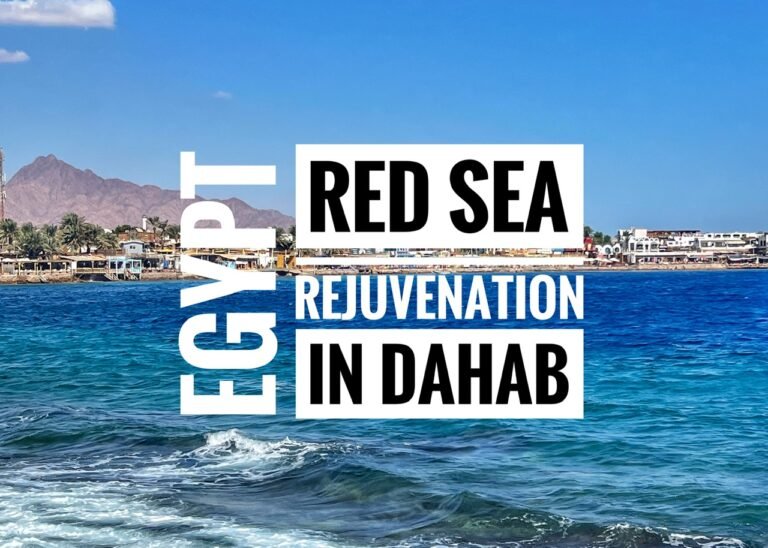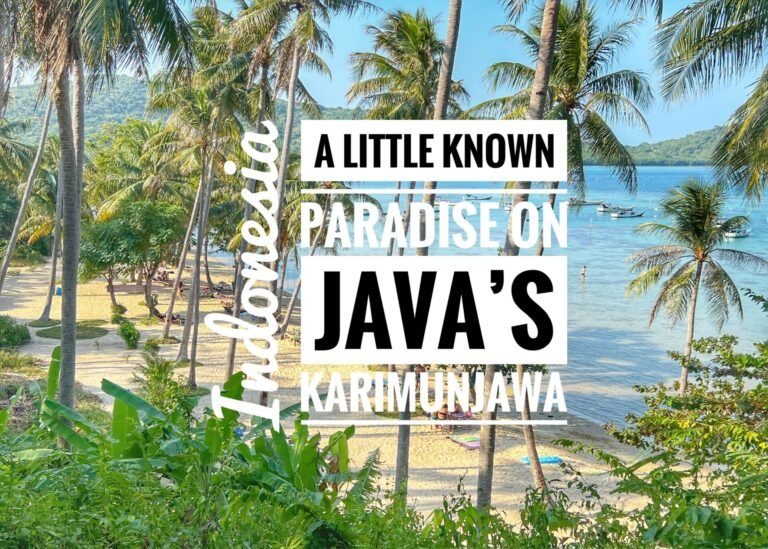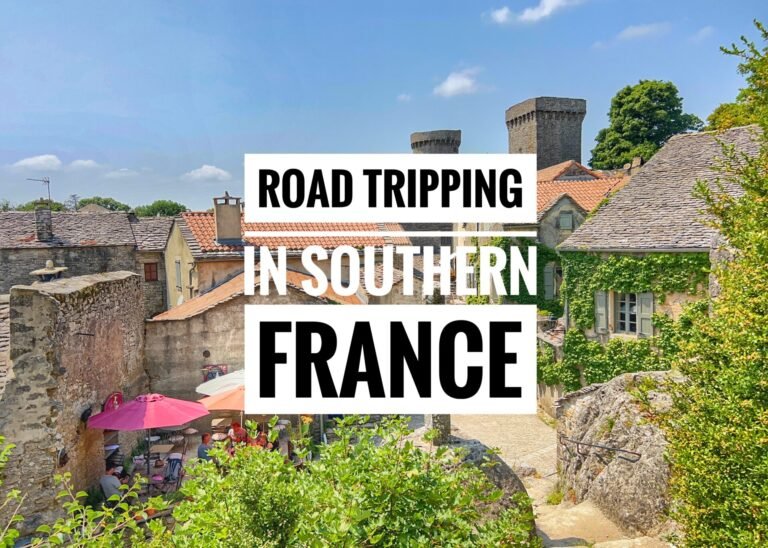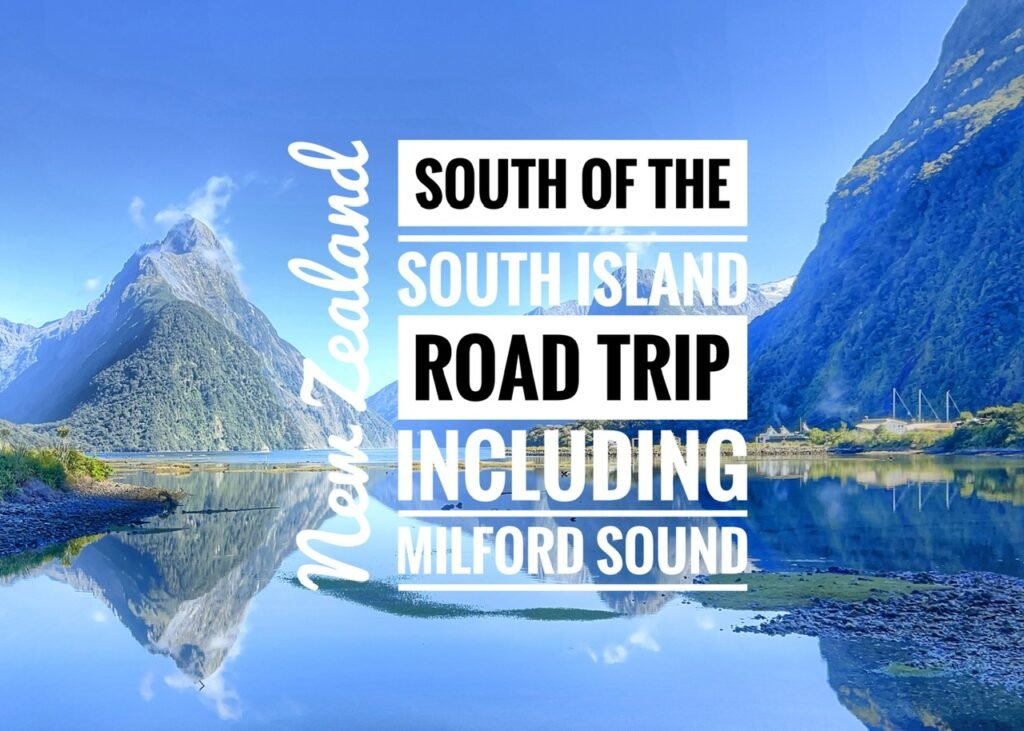
Day One: Wanaka to Queenstown to Milford Sound
From Wanaka, we took a substantially priced bus ($20/each) for a one-hour ride back to the airport in Queenstown, where we were to pick up a four-night car rental, which we had scheduled a couple weeks before for the bargain price of $25/day through Omega Rental Cars. Unfortunately, we committed a grave first-time error. WE BOOKED THE WRONG DATES. Big oops. Yep…MARCH 22-25, instead of February. And naturally, the cars were all sold out at Omega, being the high season. In fact…everyone was.
Thus, we had to scramble to find an alternative plan….especially because we had just booked a non-cancelable tour, expensive (yet points-generating) tour, at Milford Sound. Thankfully, we found another company that had just received a cancellation, so we snagged it for only two days, which would cost double the price of the four-day rental we thought we had. ($200 or $100/day). EEEK!!!
Yep….after 11 nights of cheaper living, New Zealand was officially expensive.
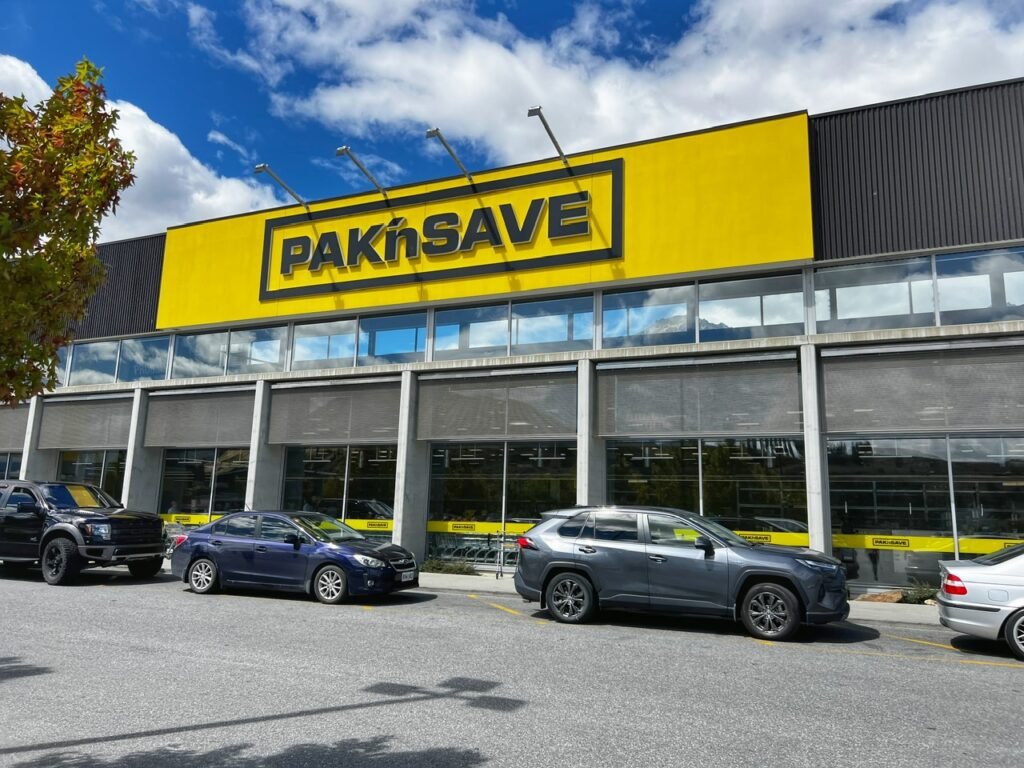
It took 2.5 hours to sort out our rental debacle, until we arrived at Pak ’N Save, which is the most thrifty, and probably trolley-jammed, supermarket option in Queenstown, which set us back about $69 for groceries that would last around 5-7 days. All in all, the grocery prices seemed pretty reasonable…at least at this particular supermarket!
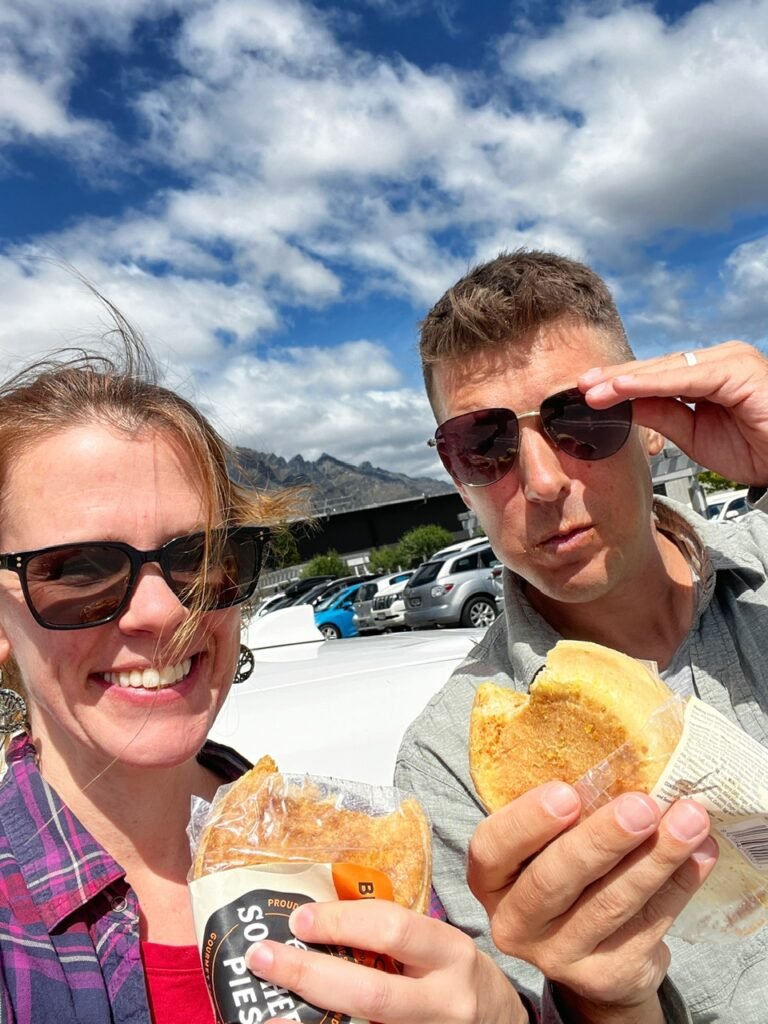
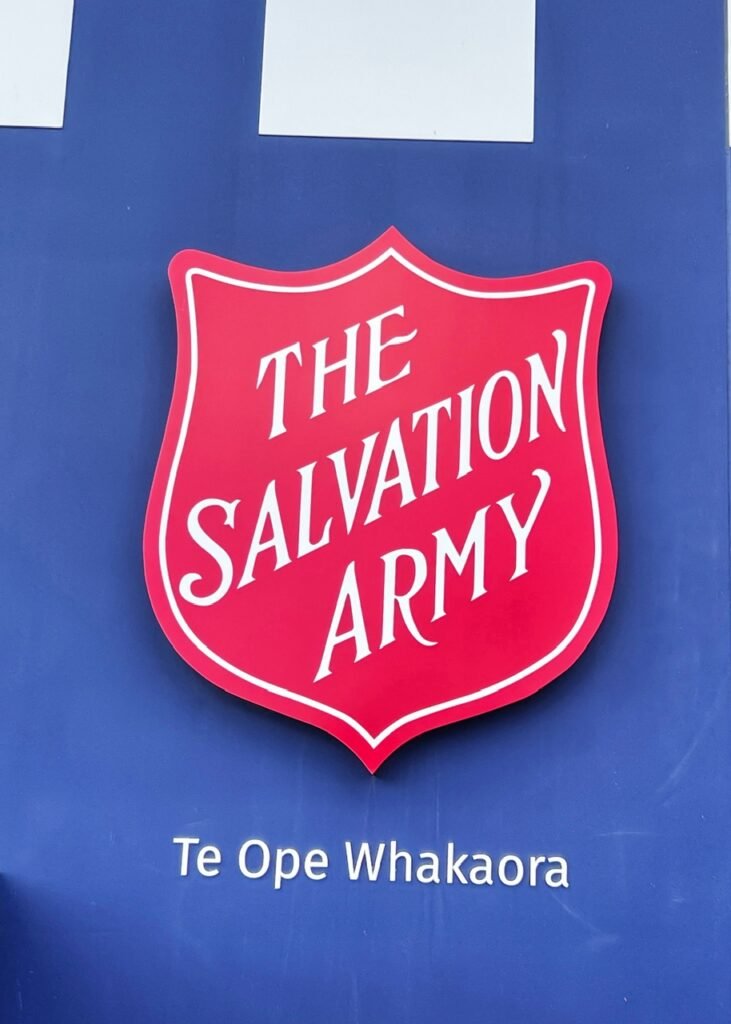
We were also growing peckish so we grabbed a sinful treat in the form of butter chicken crammed into pie formation. Thank you British influencers of New Zealand for this special gift.
The next stop, now that we officially had a car, was the good ‘ol Salvation Army, so we could grab another blanket to prep for the frigid night temperatures we’d soon be encountering and to enhance our vagabond appearance. Little did we know, we’d be stopping for yet another. They charged us $12 for a (real) wool blanket, sprinkled with feathers from something, while the other Salvation Army in Wanaka had charged us $2 for a (synthetic) blanket. Apparently, Queenstown is overpriced no matter where you go.
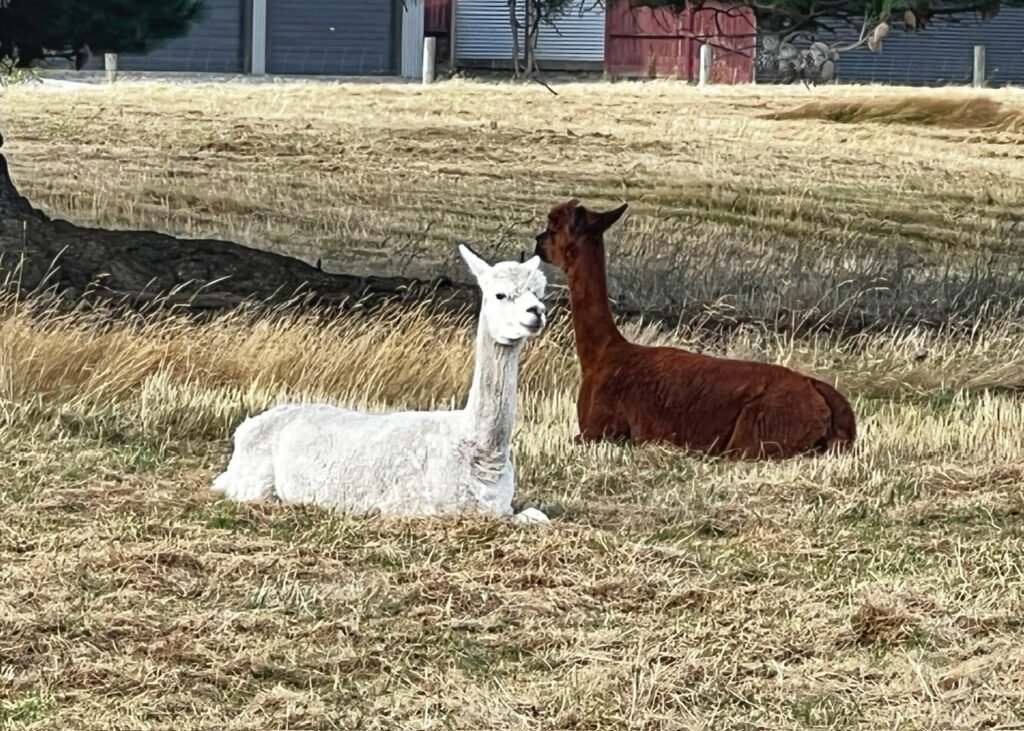
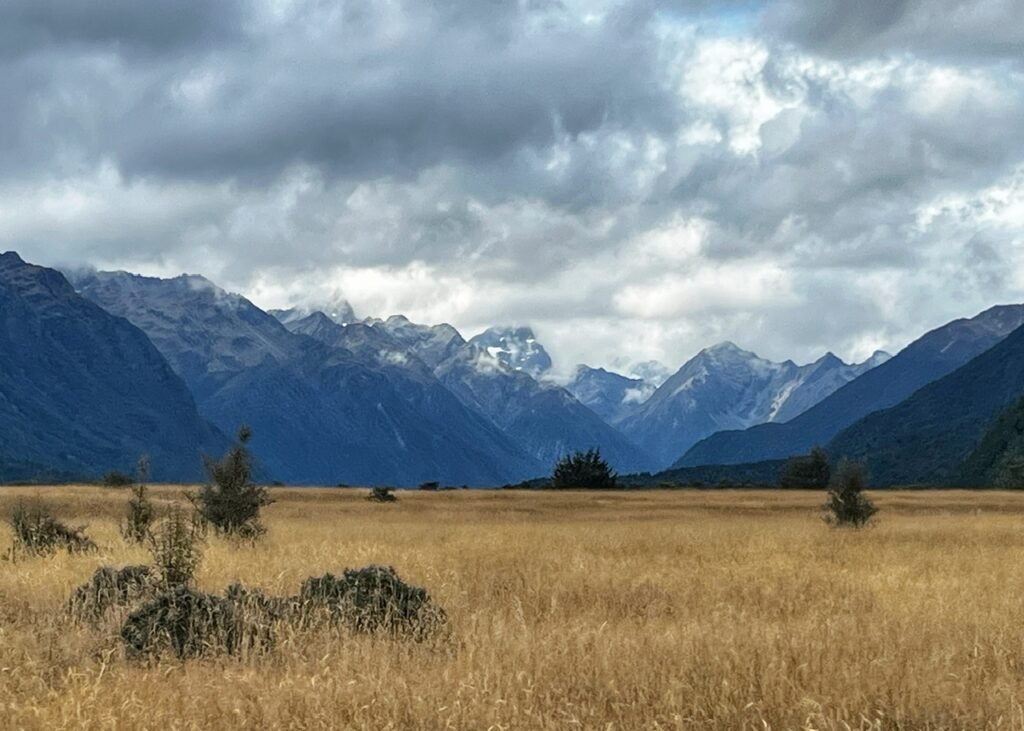
Arriving 1.5 hours later to the town of Te Anau, we didn’t have much time to stop, but we pulled over to check out our first Kiwi alpacas, and to begin admiring the luscious views.
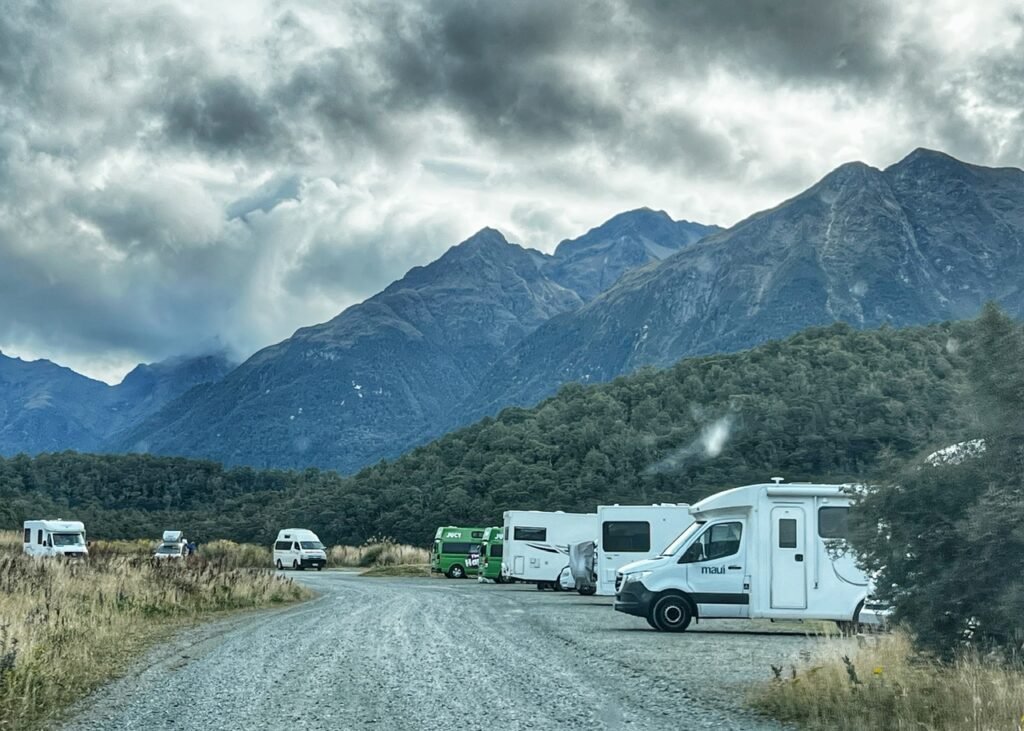
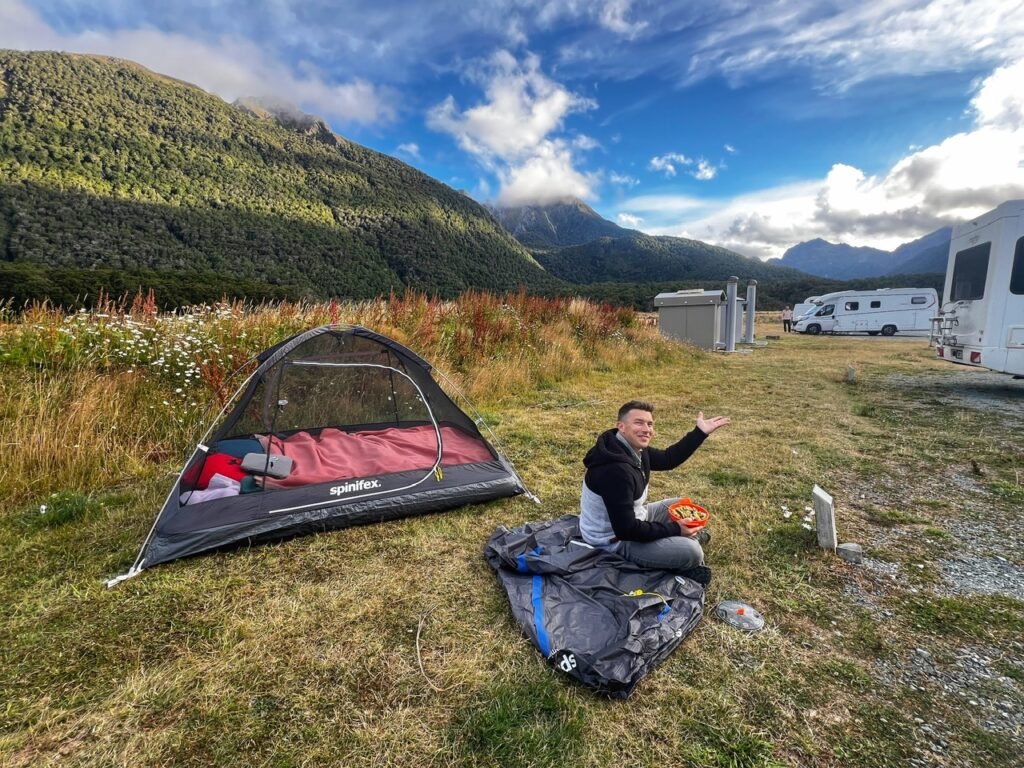
We then drove another 1.5 hours to the Cascade Creek Campsite, where we experienced our first night of Kiwi Camping at a DOC (Department of Conservation) site for $17/night. Afterwards, we reflected on our 12 nights, and can officially state that camping in this country can be extremely hit or miss….but maybe more miss? This is not what we were expecting.
The campsites are a far cry from the separated sites we experience in the States, and even Australia. Although the views are often killer, they are often plopped down in the form of free-for-all parking lots where you’re right on top of your neighbor, who is 95% likely to be in a camper van, and not another tent. There are also very few or no picnic tables, making it quite un-friendly for those of us in a tent, without chairs or a table to sit on. Yet, we made do by transitioning our tent cover into a romantic picnic blanket. And…at least it wasn’t raining!!
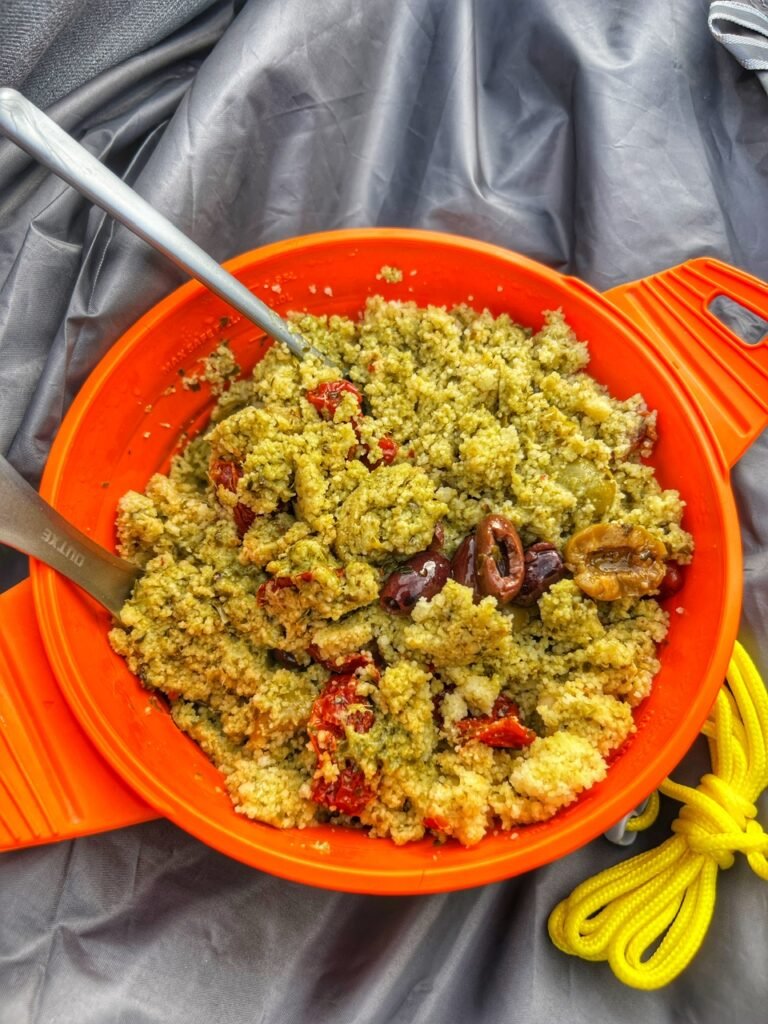
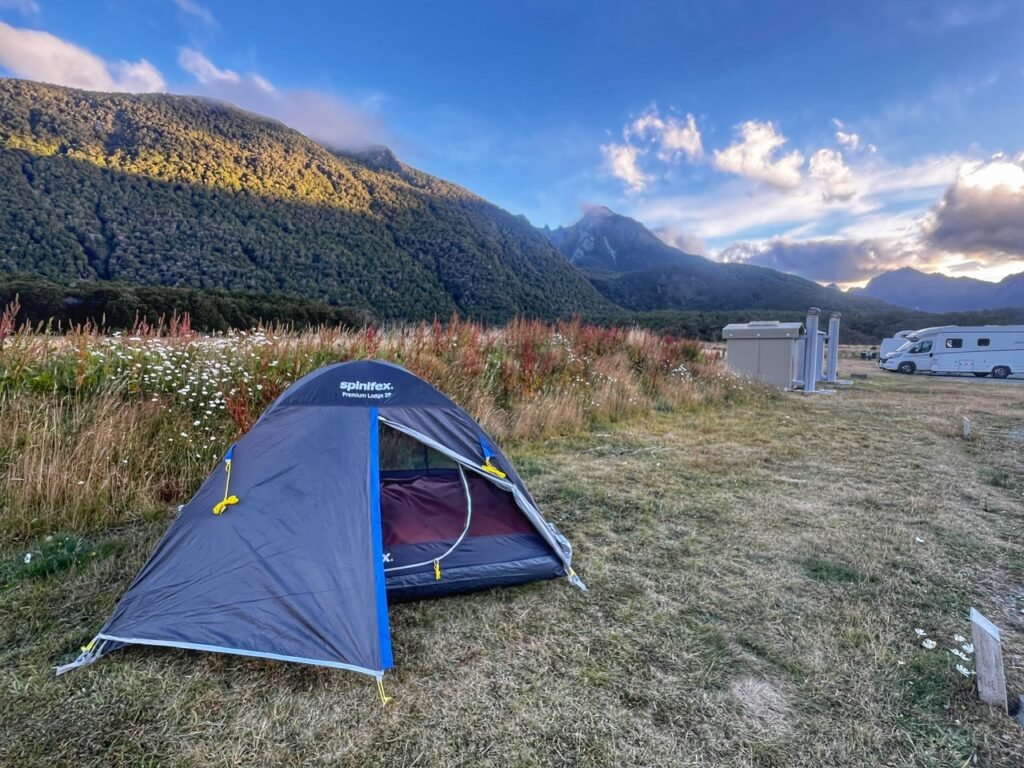
Our dinner on night one was couscous, mixed with olives, peppers, sun-dried tomatoes and olive oil.
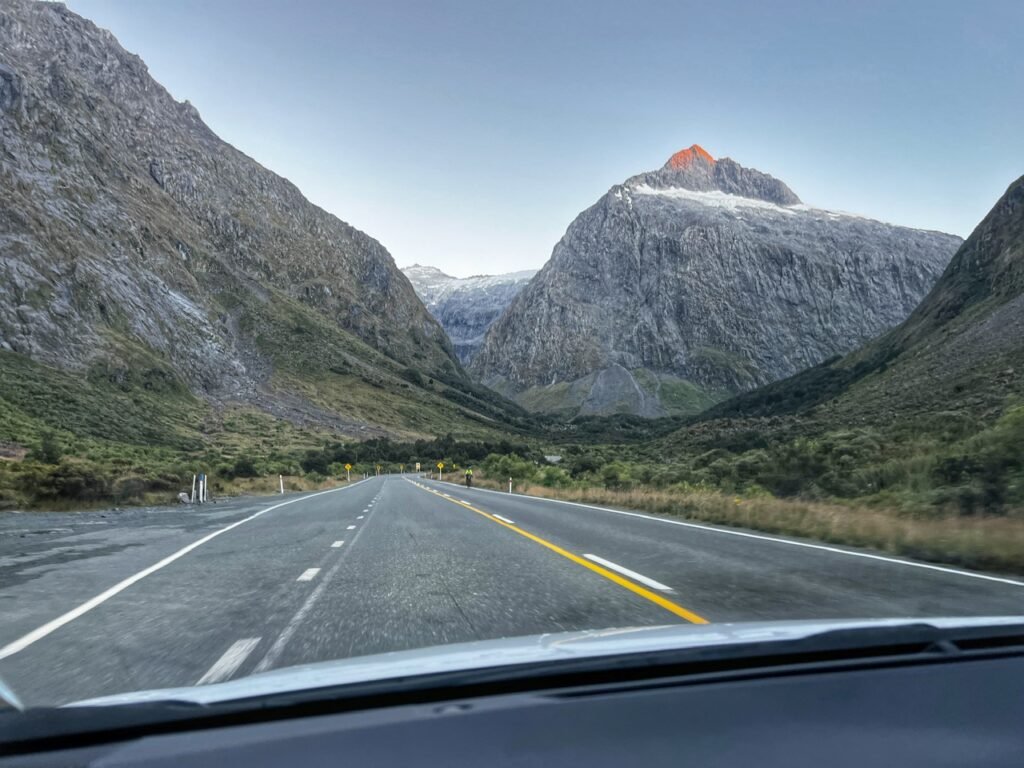
After an endless, and nearly freezing cold night where the only heat was from the gases emitting from each other, we agreed we needed yet another blanket. Ah, well, the day was already shaping up to be stunning… AND we were heading to Milford Sound!!
The Magic of Milford Sound
After an endless, and nearly freezing cold night where the only heat was from each others’ gas emissions, we agreed we needed yet another blanket to continue camping in New Zealand. Ah, well, the day was already shaping up to be rarely stunning… AND we were heading to Milford Sound, aka Piopiotahi…a long-time item on Mandy’s “60 by 60 List.” This sound (which is actually a fjord) on the south of the south of New Zealand is known to be one of the world’s most breathtaking areas of its kind and the only one accessible (in NZ) by road.
That said, more than 1 million tourists a year amble here like bused cattle trains to load onto boats, which is pretty much the only way to get into the fjords themselves. Because of this, its also a bit of a budget buster, which naturally led to a $180 drop in our splurge account. The question…was it worth it?
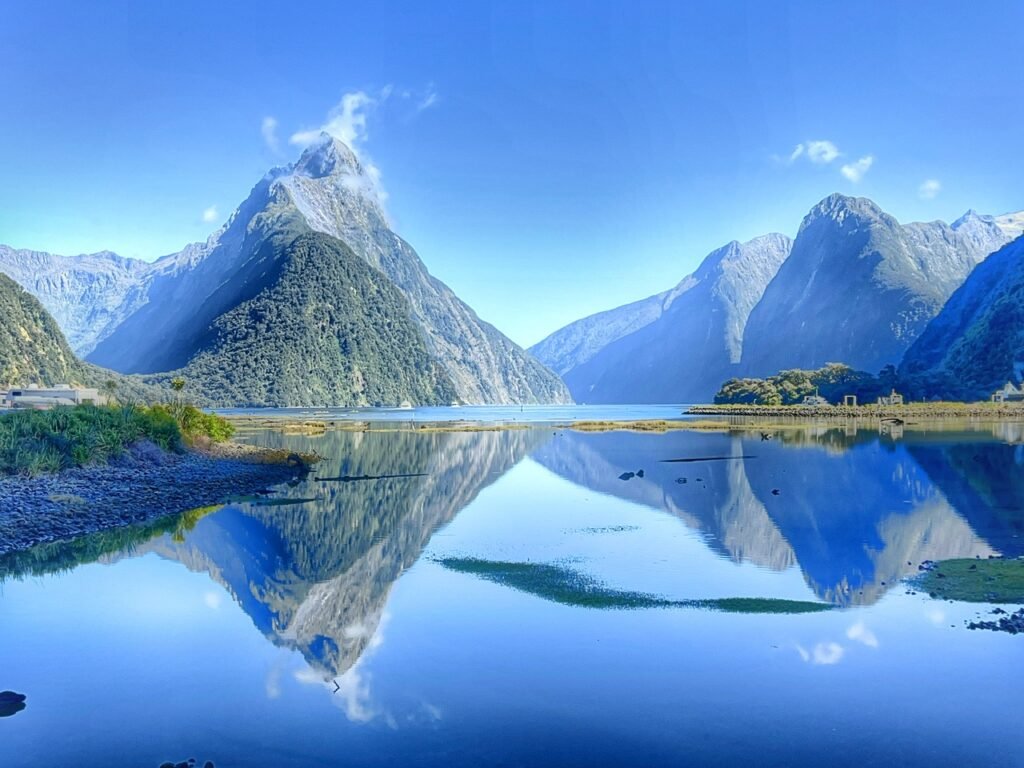
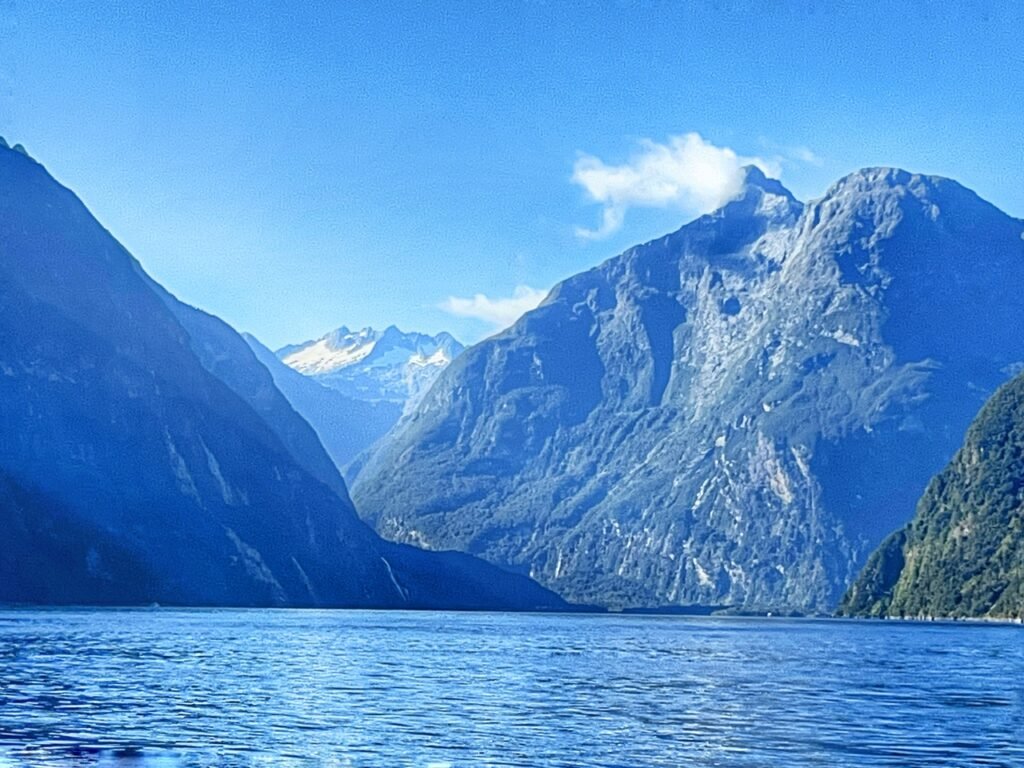
In short, the answer was no….at least for us budget-conscious people. As is often with these types of places, we were a bit disappointed, mostly due to our high expectations, especially when the most remarkable views we got were actually attained from the parking lot, such as this one. Don’t get us wrong…the views on the tour were gorgeous, but we personally just felt it was a bit overhyped for the price tag, especially with other places we would soon see in the country.
So, why is this a fjord, and not a sound? A sound is created when a river valley fills with seawater, while a fjord is a glacier-carved valley that is also flooded by seawater. Apparently the bonehead European explorers who named it didn’t have Chat GPT to verify.
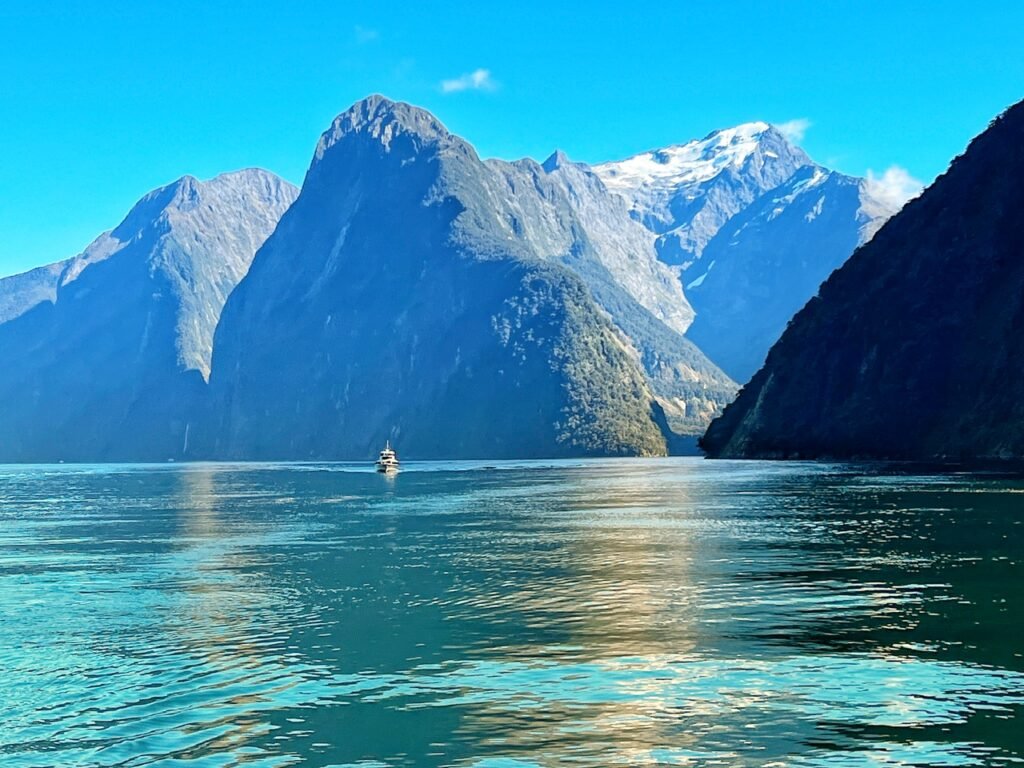
The best part of the boat trip was floating upon this aquamarine slice of sea. What a backdrop!
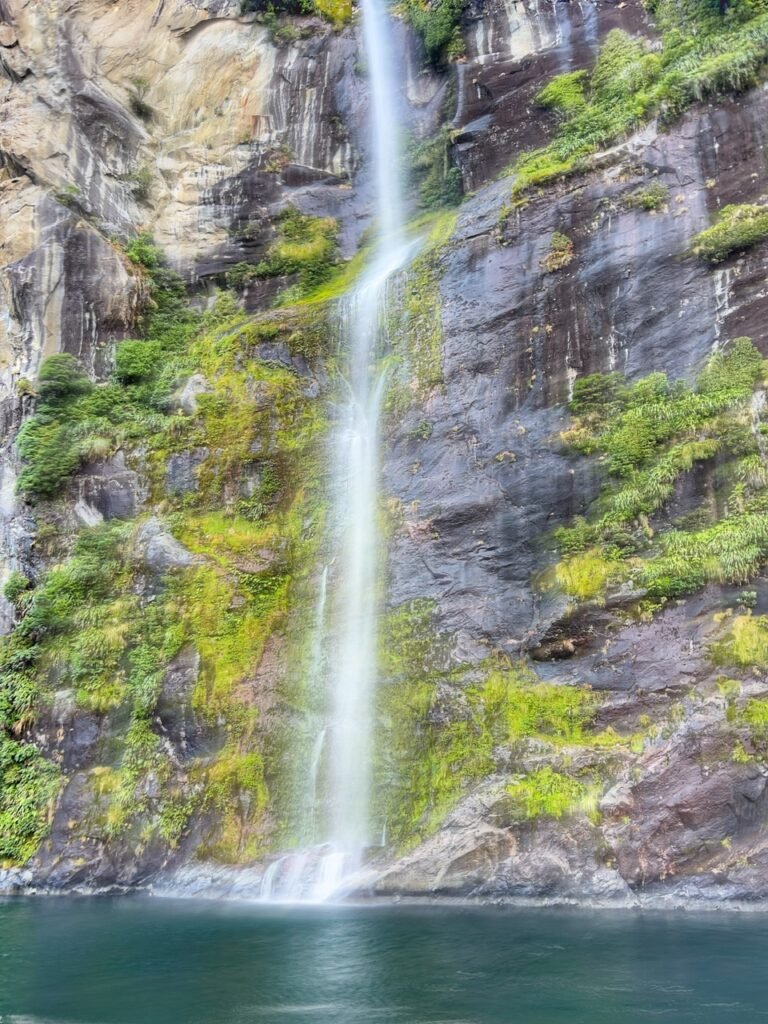
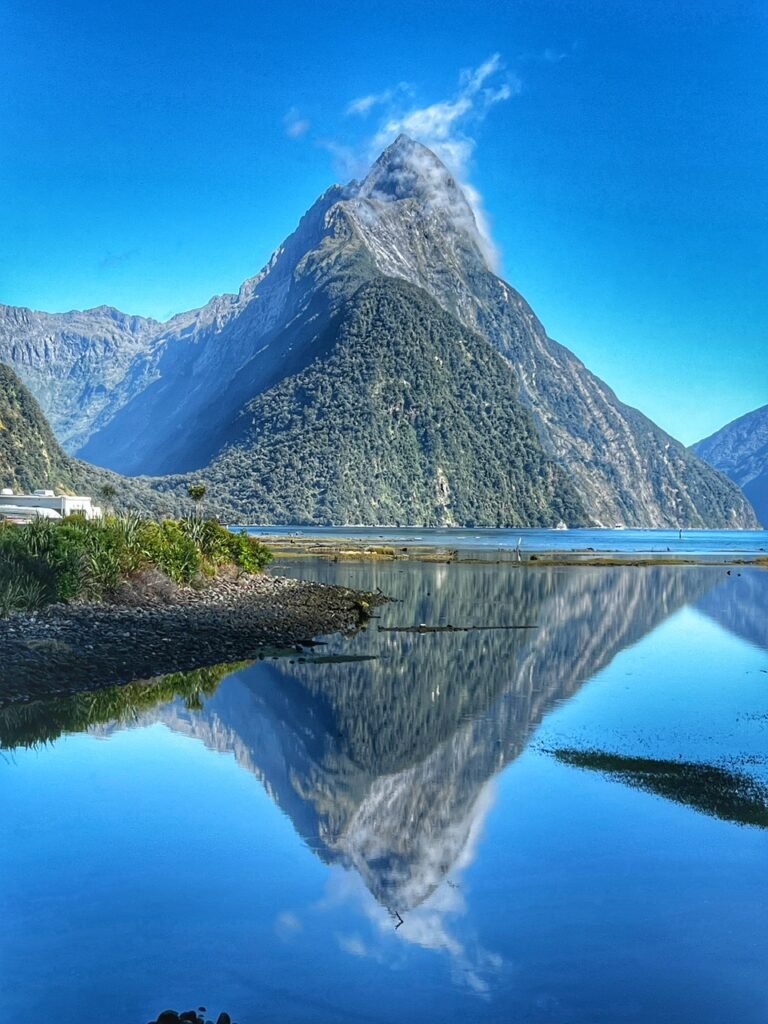
There were also multiple waterfalls for your viewing pleasure. Backing up, again this was the view from the parking lot, where we planted our car for the bargain price of $17. There is an option for free parking further up the road at Deepwater Basin Road, but it didn’t seem overly secure for all our life’s belongings.
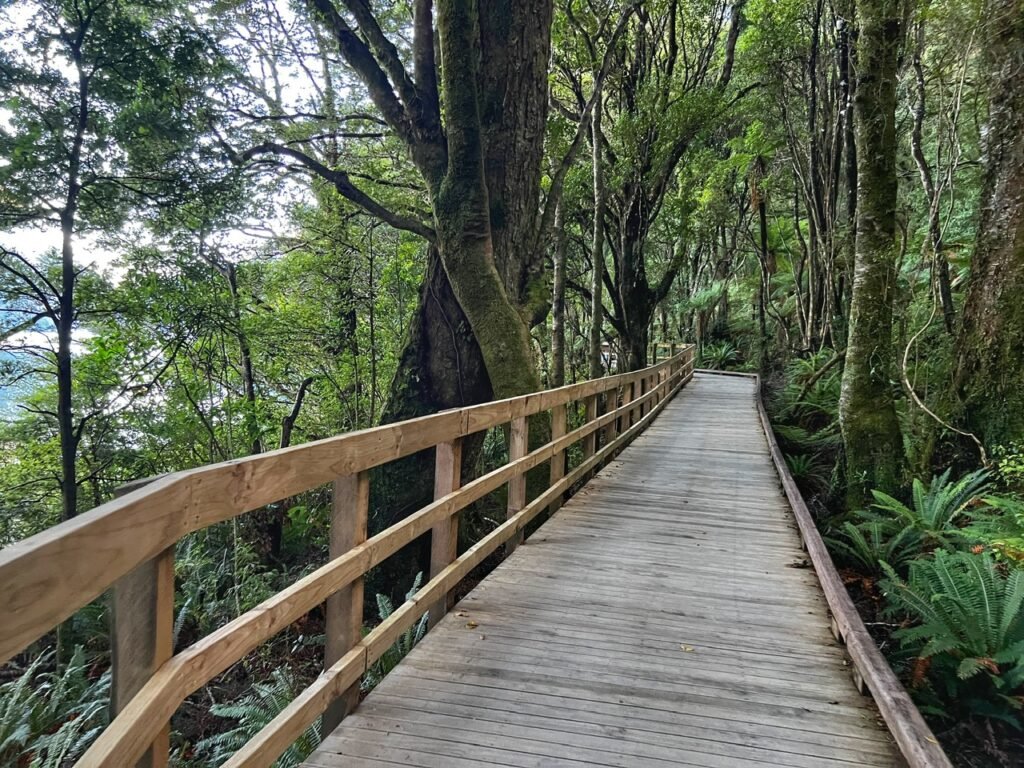
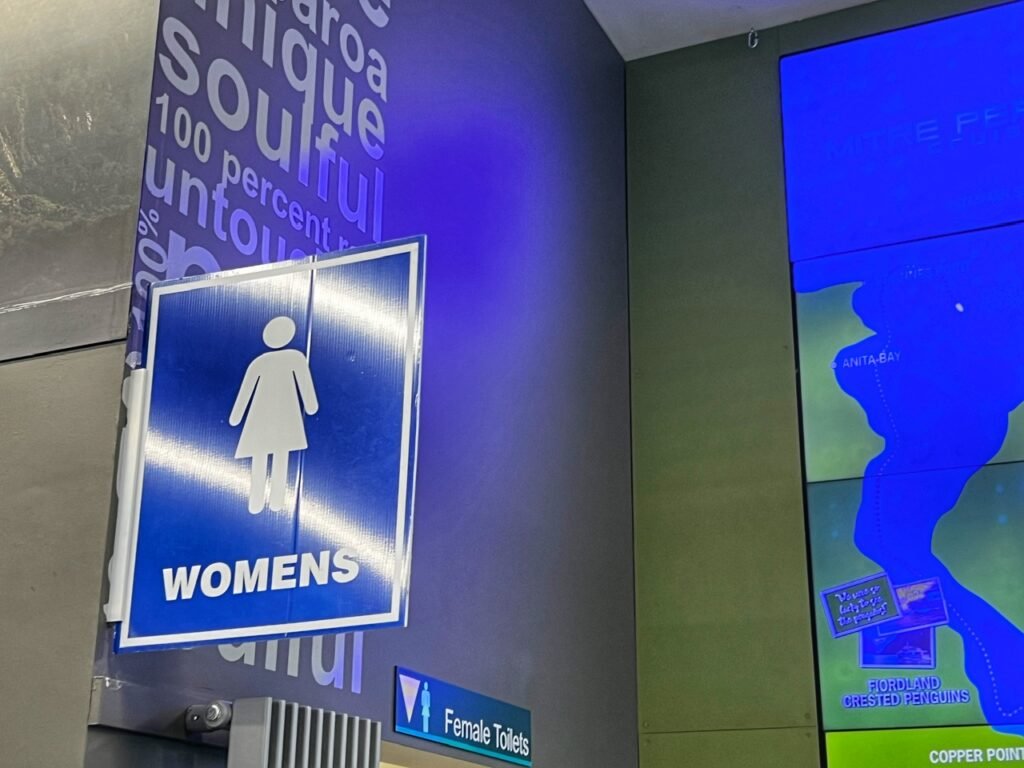
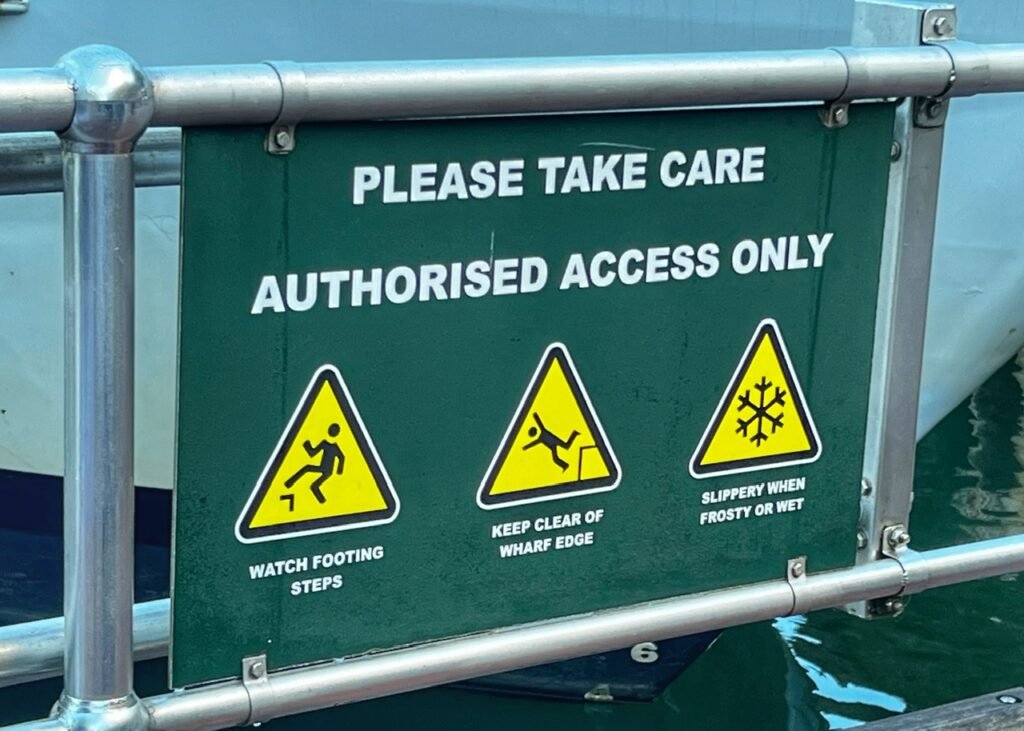
Once we parked, we strolled around 5-10 minutes along a lush forested path to find ourselves at the visitor’s center, where we’d learn that kiwis may not know proper English, or maybe they just have some different ways of saying things? Haha.
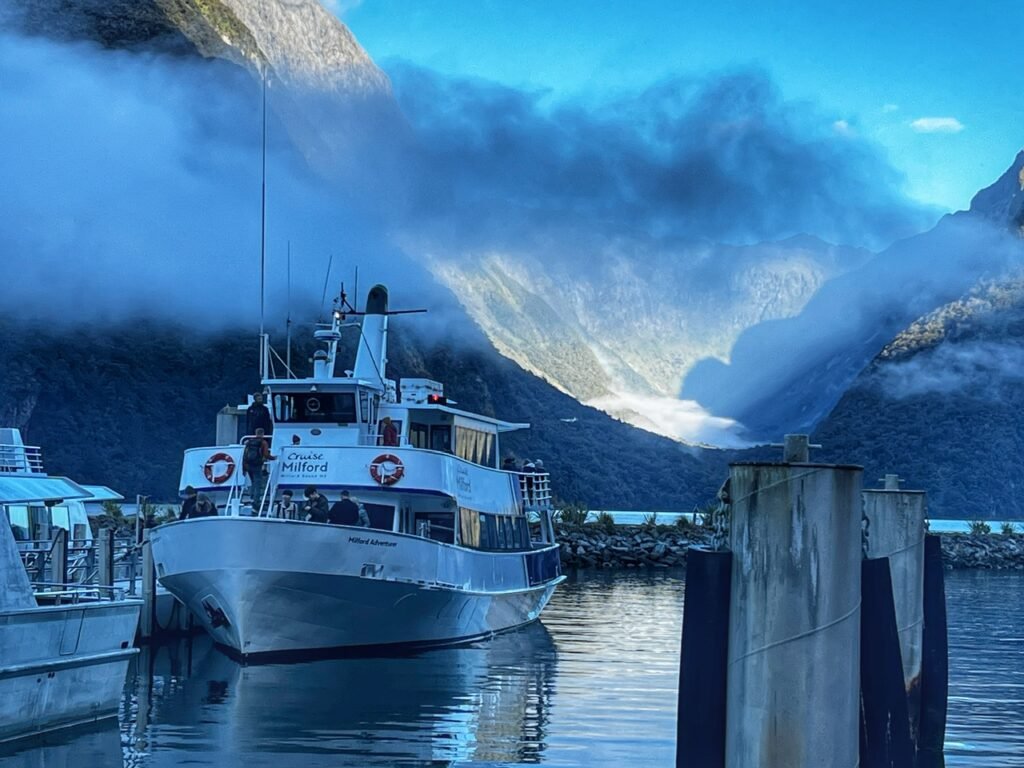
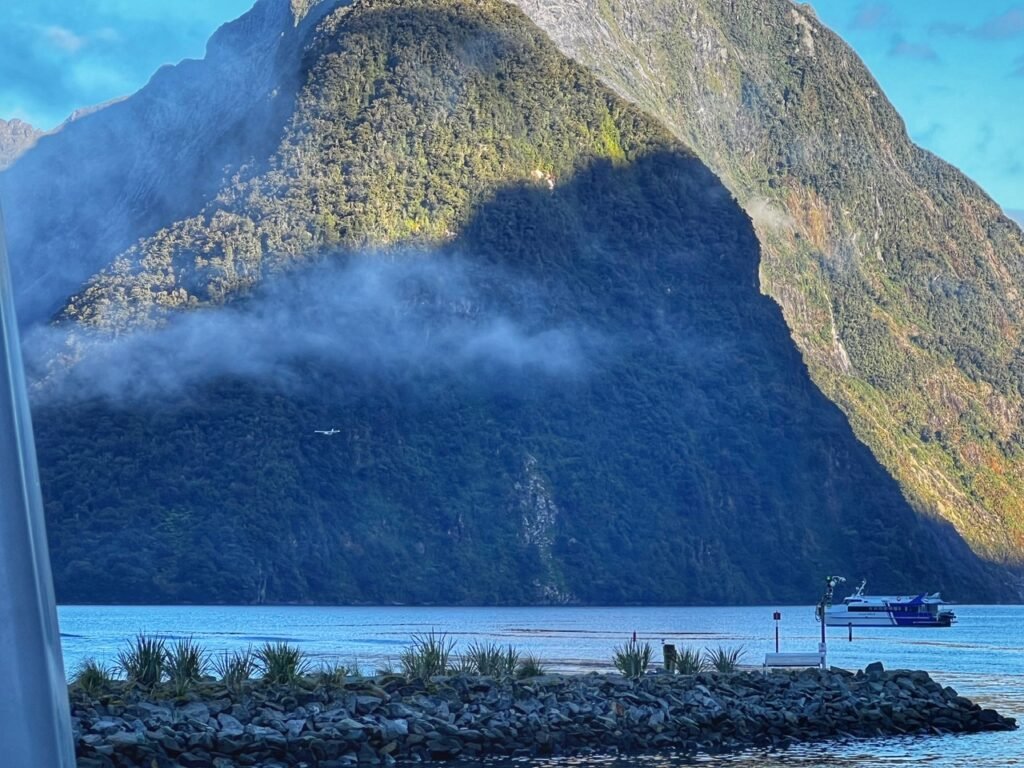
Arriving to our 8 am cruise boat, which was enveloped in a thick shroud of morning mist. While we were waiting to board, we learned there is actually another way to get into Milford Sound…via 12-seater airplane, which probably costs a wee bit than our self-drive, but undoubtedly offers a superior experience. You can see the tiny toy if you zoom in.
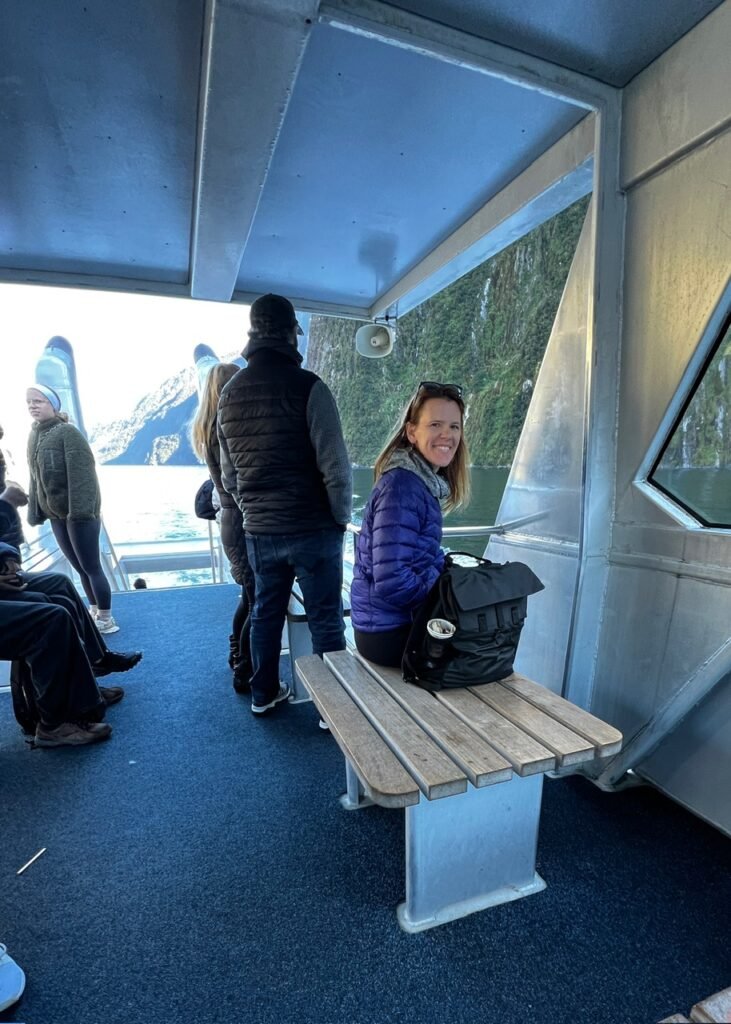
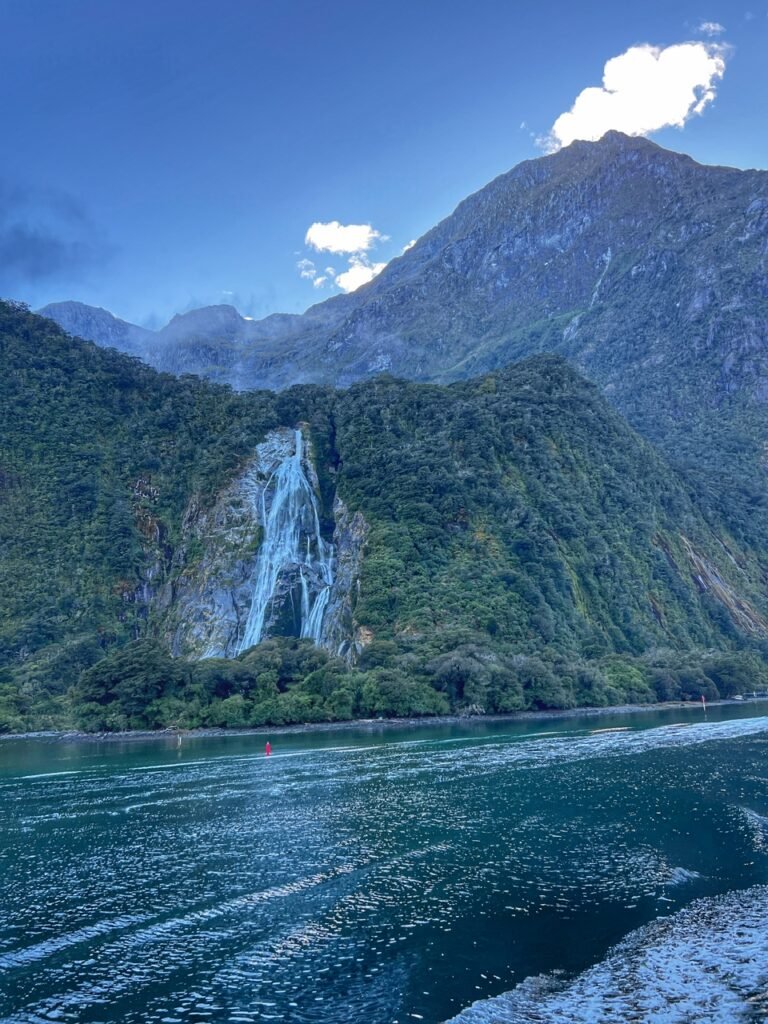
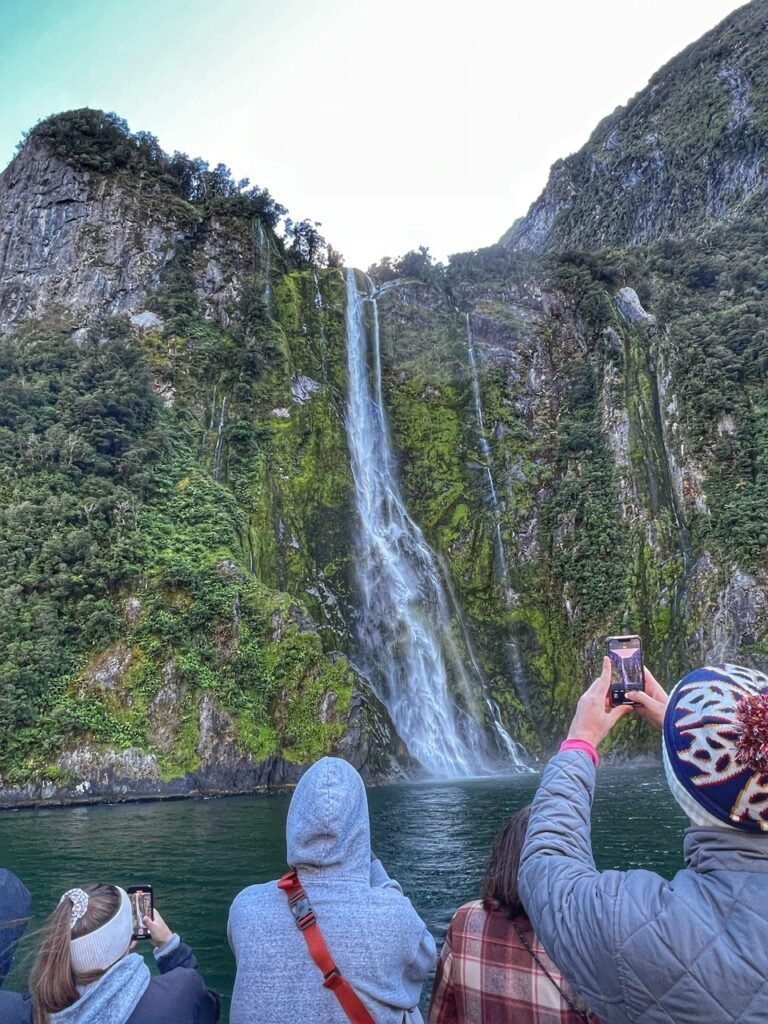
Boarding the boat, we managed to find the best seat in the house by heading upstairs for unobstructed, windowless views, but still tucked under the edge of the awning so we didn’t get splashed.
The first waterfall of the morning, known as Stirling Falls. The next photo…what it’s actually like.
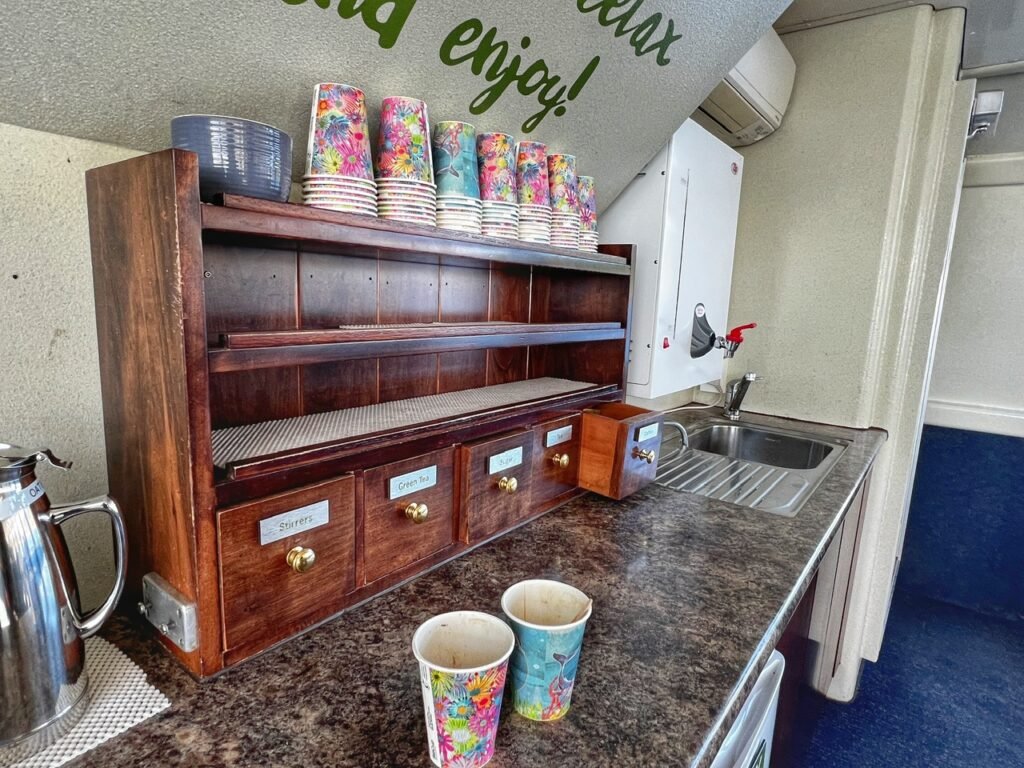
And since it was a undoubtedly brisk morning, the complimentary coffee and tea were welcome warming fuel.
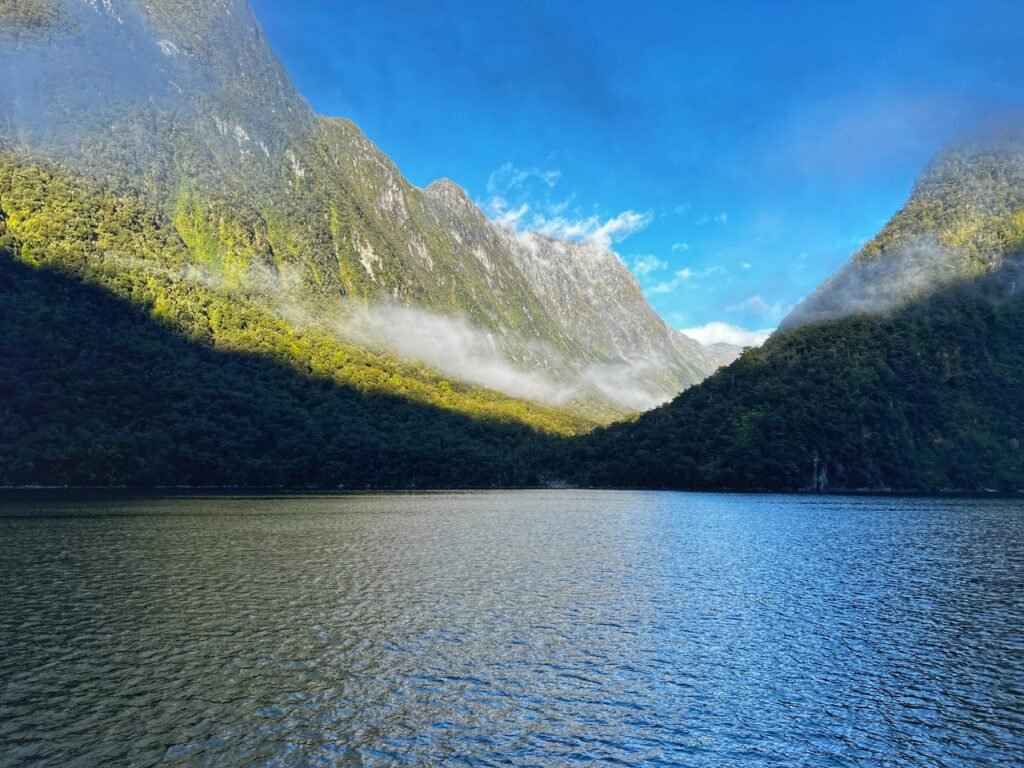
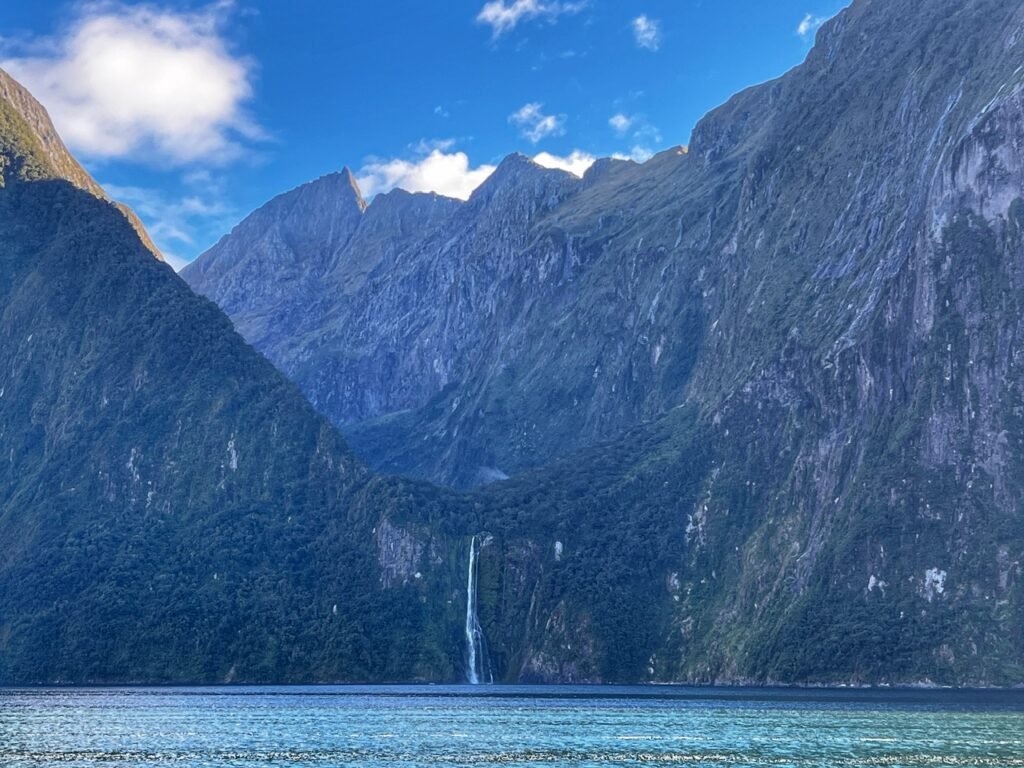
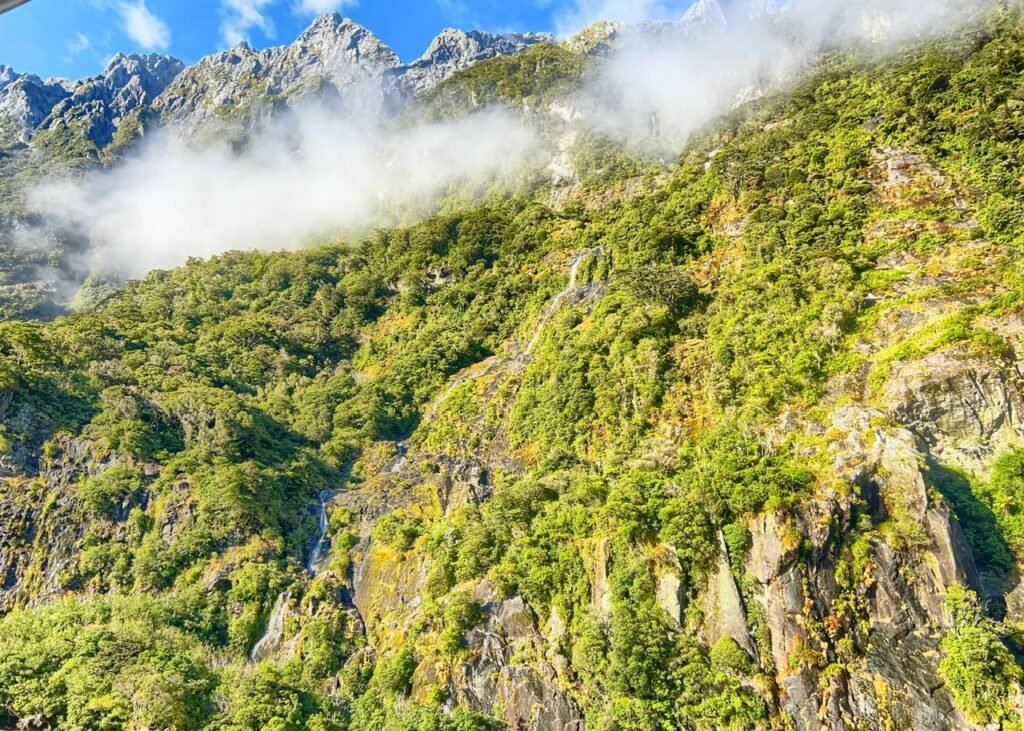
Milford Sound is a part of Fjordland National Park and is a UNESCO World Heritage Site. It’s one of the wettest places on earth and experiences an average rainfall of over 6.7 metres (22 feet) each year, spread over approximately 200 days. Surprisingly, the summer months of December & January are actually the wettest. Fortunately, when we arrived in February it was on one of those extraordinary, crystal clear days, which gave us uninterrupted views of the jagged peaks encompassing us.
Although it’s known as a land of waterfalls, there are actually only two permanent ones, including Lady Bowen Falls, which measures 162 meters. This waterfall generates the electricity and water supply for the village of Milford, which only has 120 permanent residents. There are also plenty of not-so-permanent falls which pop up wherever they please and are completely dependent upon rainfall.
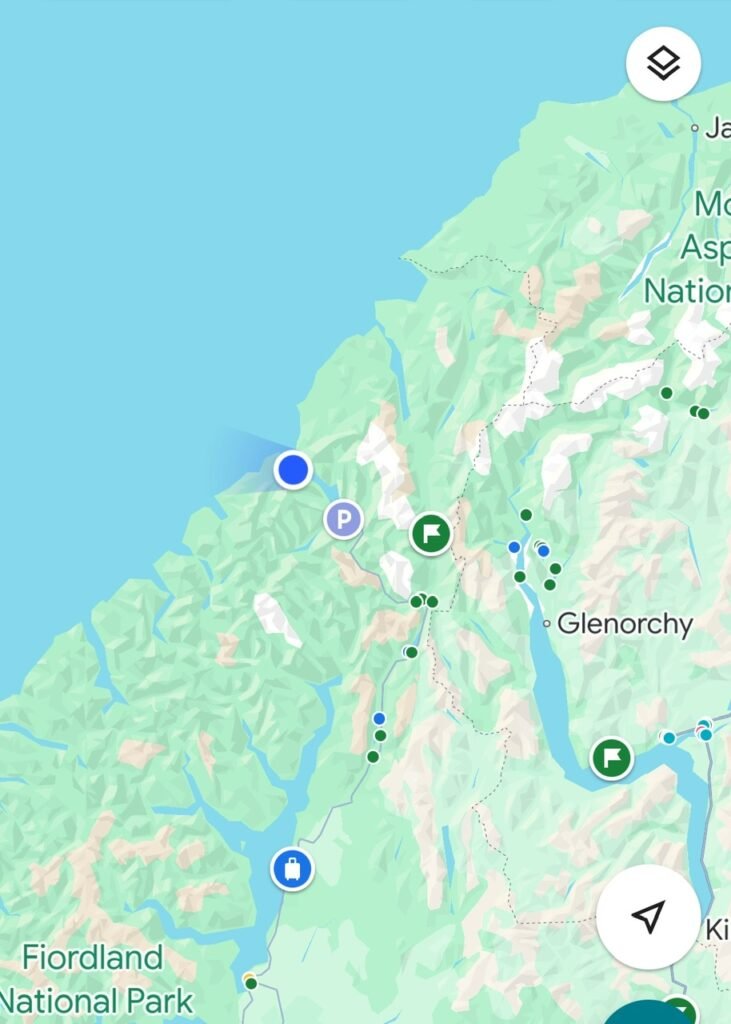
The two-hour boat tour is actually pretty brief and only goes from the parking lot to the mouth of the Tasman Sea, which is what separates New Zealand from Australia.
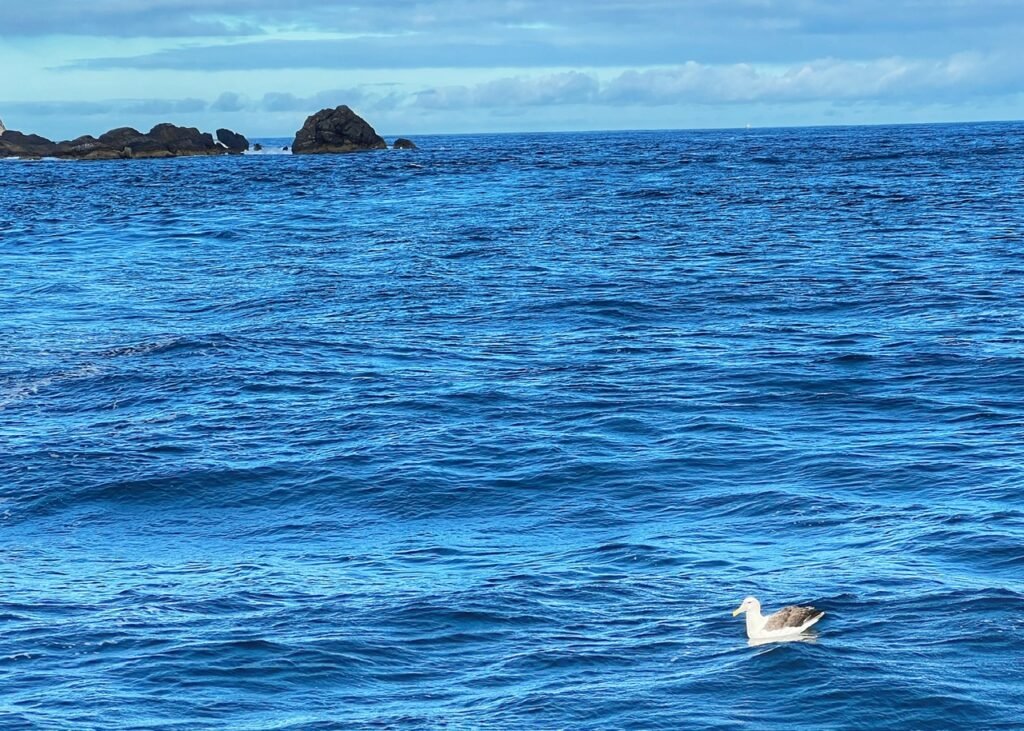
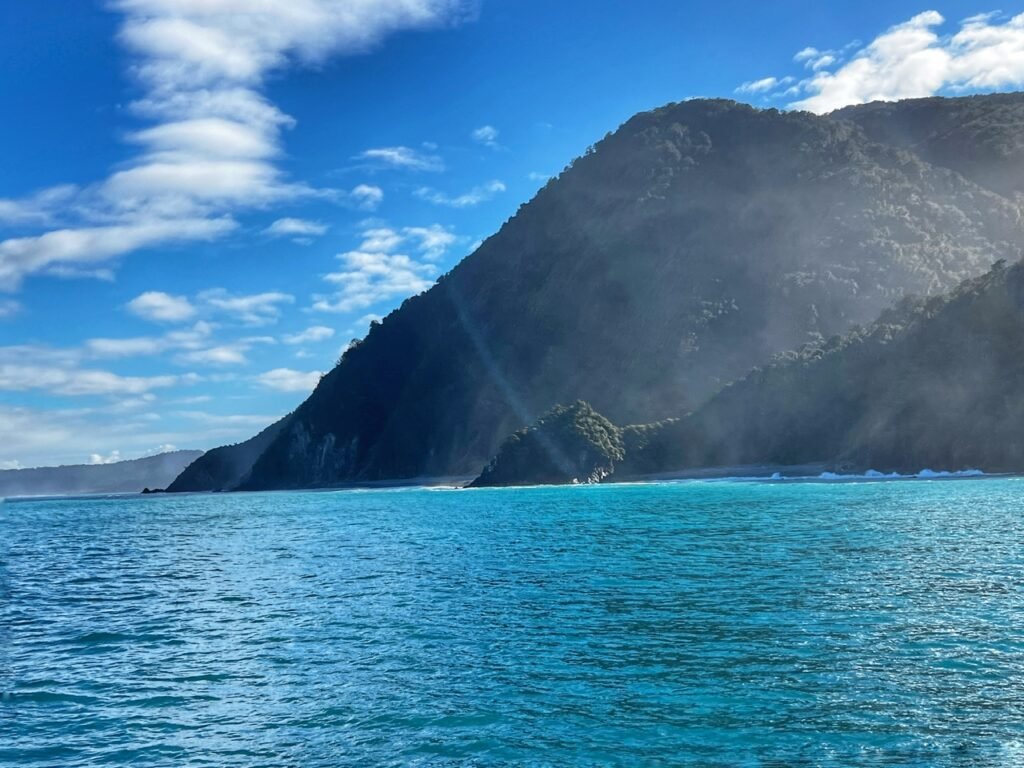
It’s also where we saw our first albatross, the birds known to have the biggest wingspan on earth. This stunning aqua color is not blanketed throughout the entire sound, but only a small section. It’s a result of natural interplay between glacial sediment, freshwater influx, and the reflection of the sunlight.
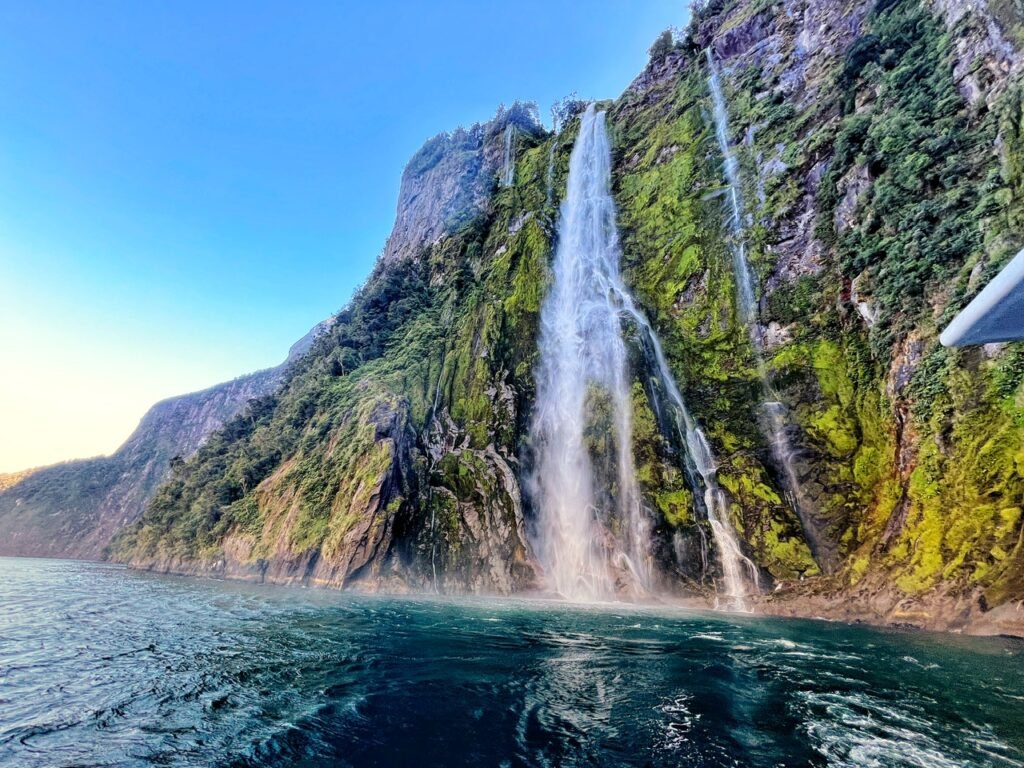

A little more icing on the Milford cake…
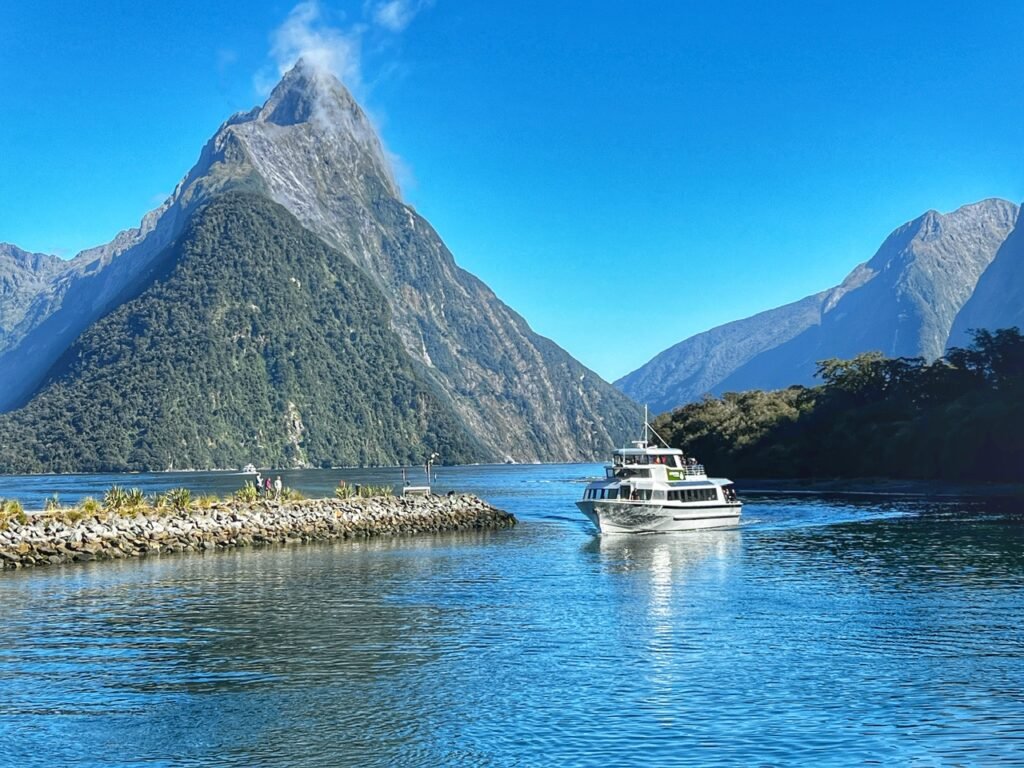
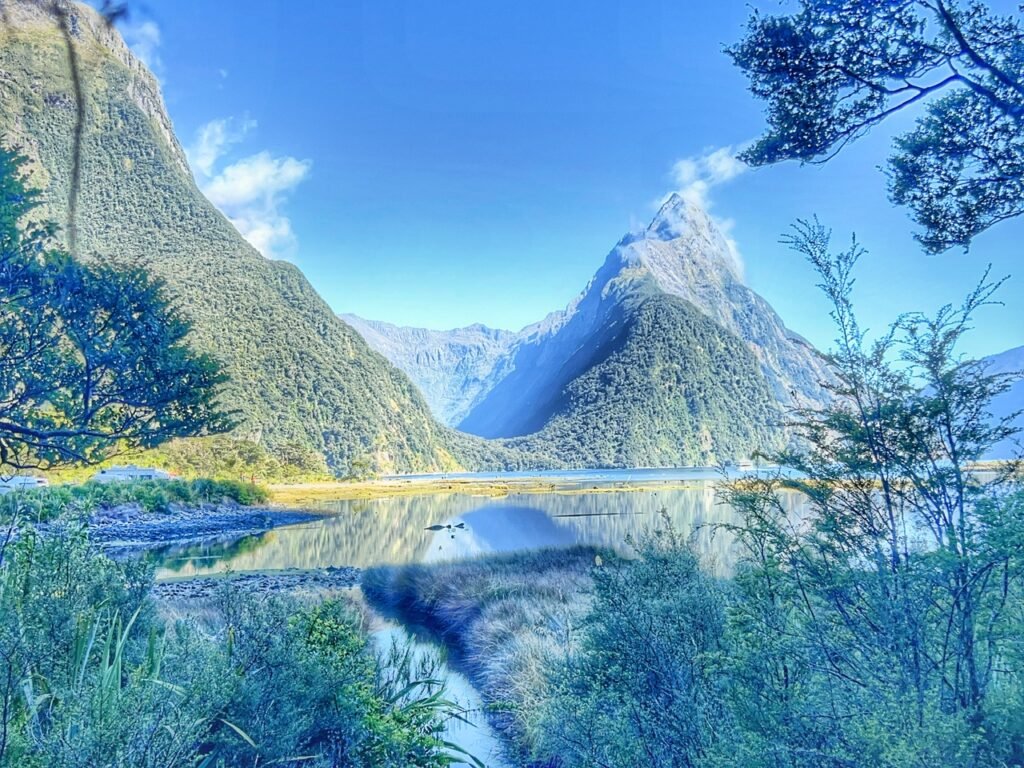
Back in the parking lot, for one last dreadful view, which we agreed while standing here it was definitely the best…especially with that mirror effect. Ah well, now we know.
Day Two: Milford Sound to Monkey Island Beach
After an exceptionally ravishing morning on Milford Sound, we continued to head to the south of the South Island where we would immerse ourselves in some lush ferny rainforests, get our llama on, stroll across the longest wooden bridge in NZ, check out the sausage capital of the country, and camp at the best free campsite of our trip on Monkey Island Beach, which was not an island, nor did it feature any primates. One reviewer even gave it a quite unwarranted 1-star because of her disappointment. Seriously? Do you know where you are, woman? 😆
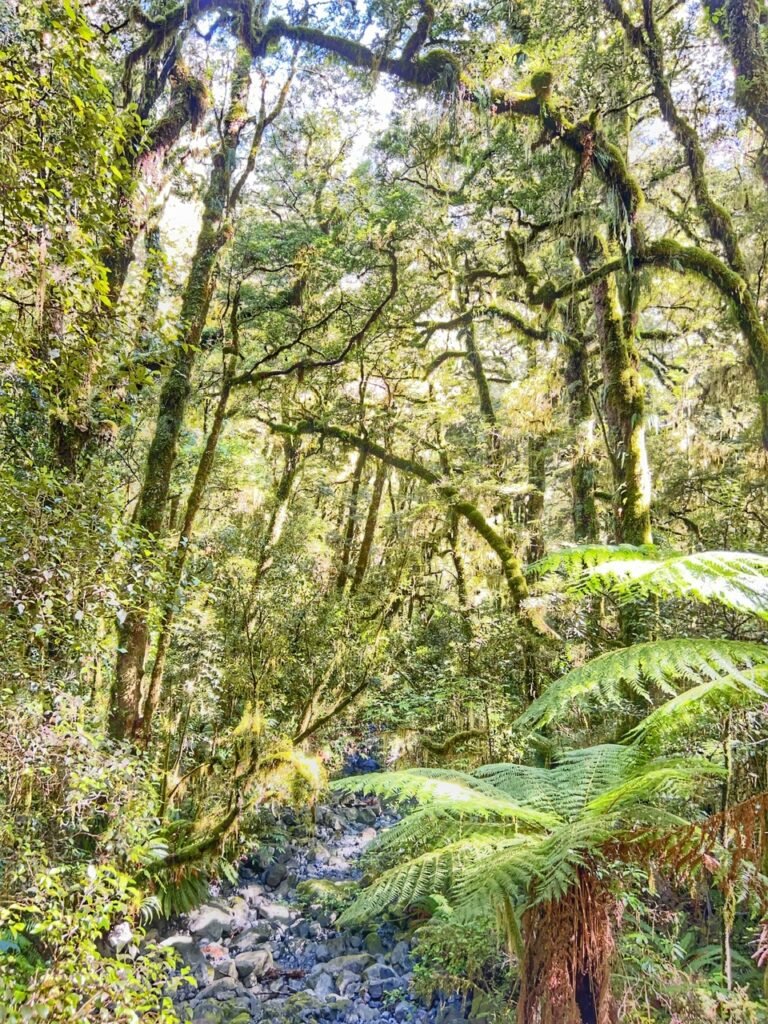
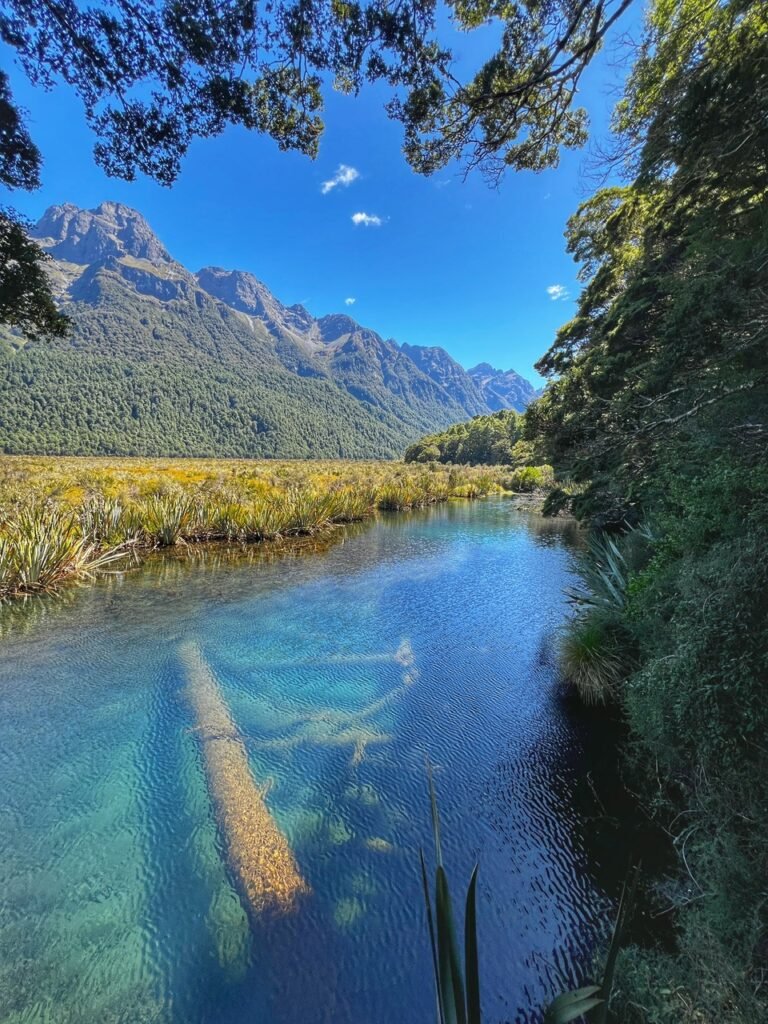
Our first stop after Milford was to Lake Gunn Nature Walk where we were able to soak in some oxygen at one of the Fjordland’s many temperate rainforests forests, which was absolutely therapeutic. Actually, most of the South Island exuded this superpower.
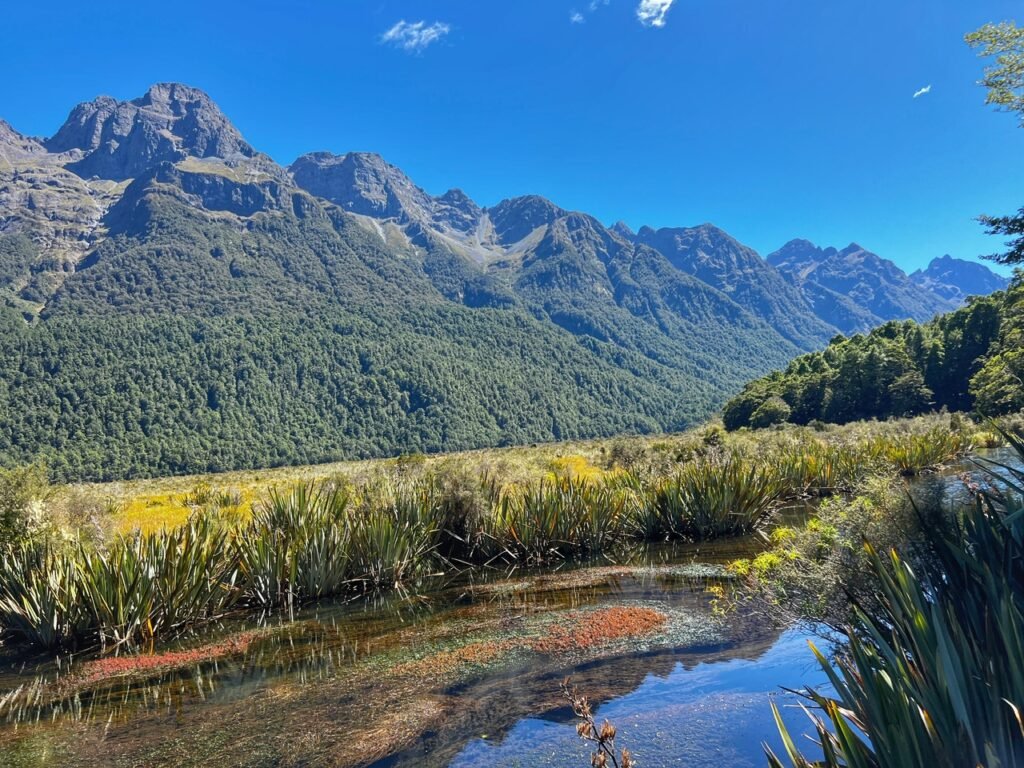
Another pause at Mirror Lake, where you could see every minuscule detail in what lies beneath the aqua surface.
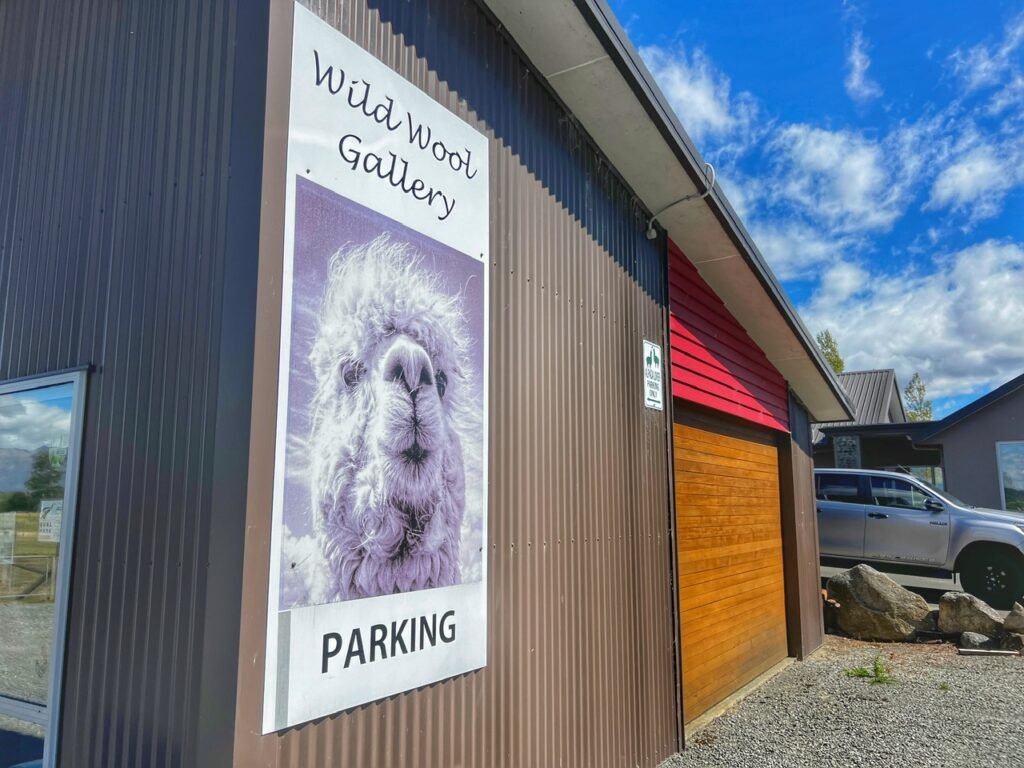
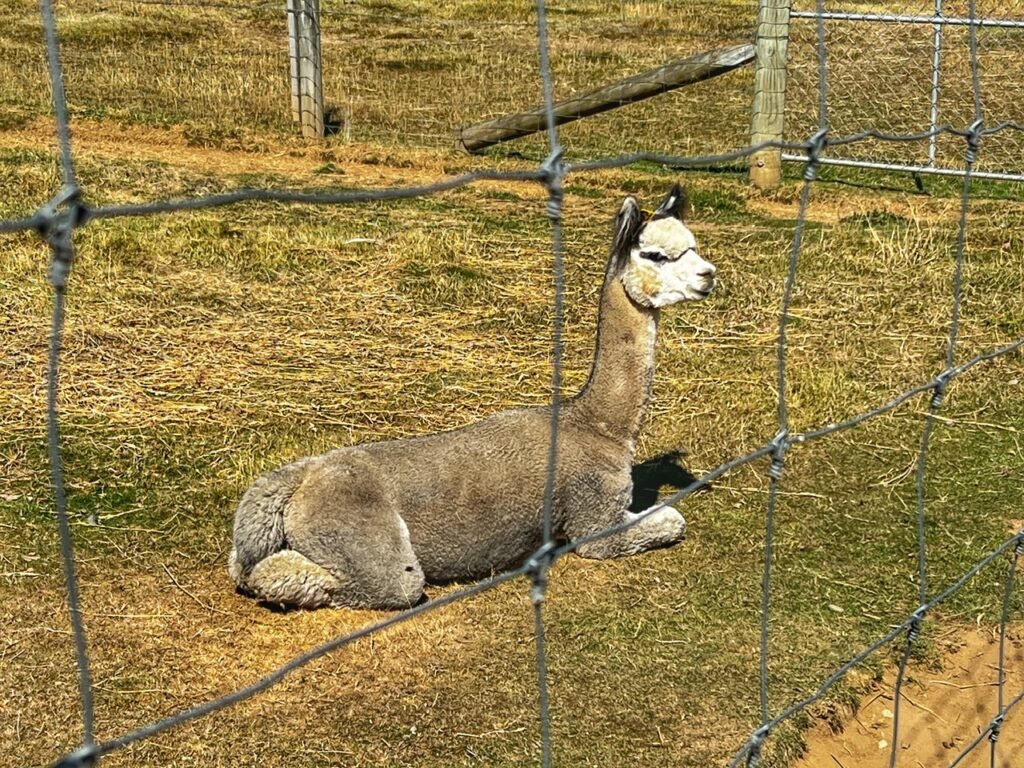
In the town of Manapouri, we stopped to check out the alpaca products at the Wild Wool Gallery Alpaca Farm. It made us very regretful we hadn’t bought any products in Peru three years earlier when the same products were about 5 times cheaper. They also offered tours for about $20 NZD and feedings at the farm, but we just checked out one of the not-so-fuzzy friends who seemed quite comfortable in his nakedness.
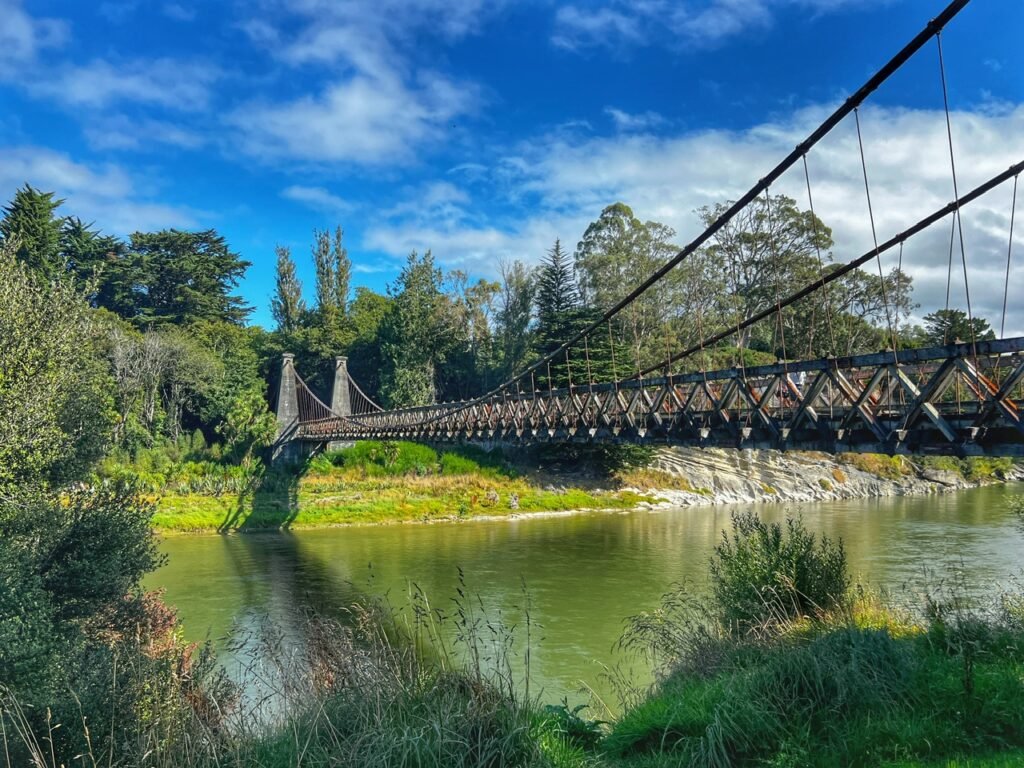
The striking Clifden Suspension Bridge is New Zealand’s longest wooden suspension bridge spanning 111.5 metres (366 feet) above the once mighty Waiau River. It was opened in 1899 and cost £5000 to develop.
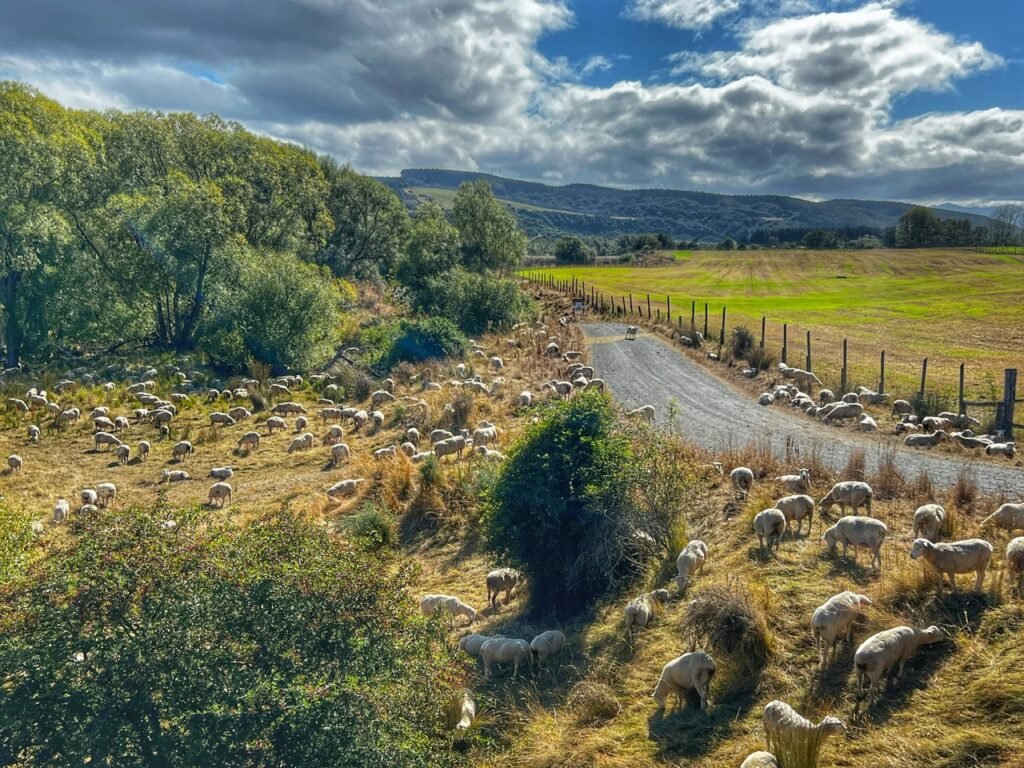
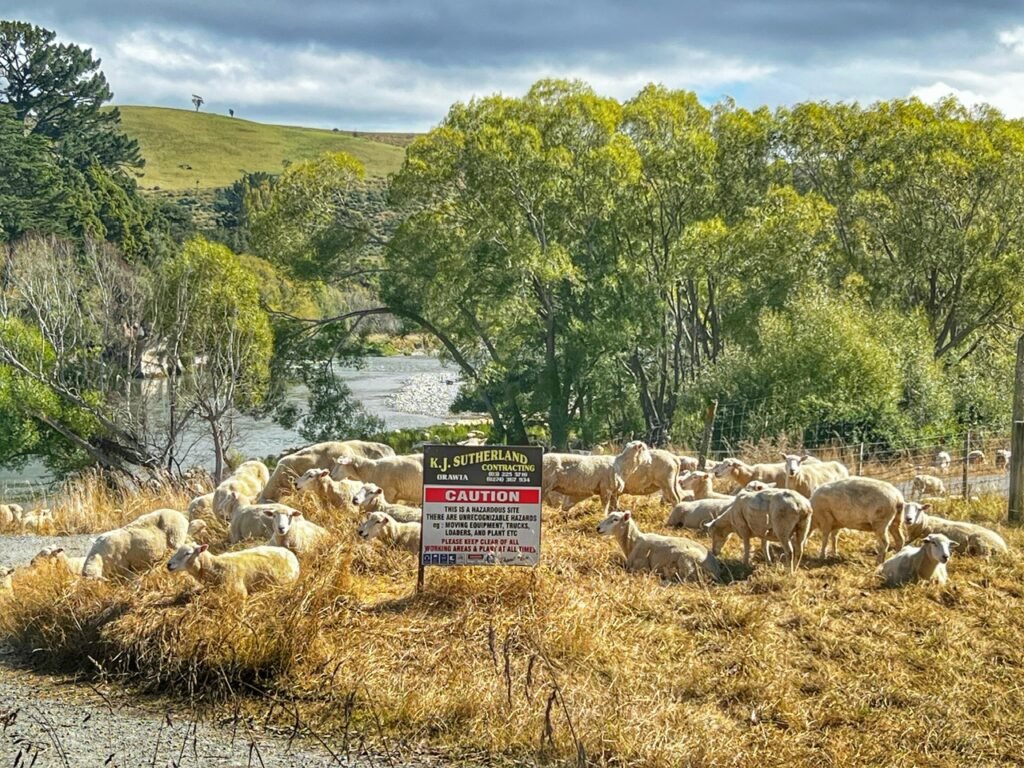
Have we mentioned there are a few sheep in New Zealand?! This herd looks like it was holding a peaceful protest against the developers.
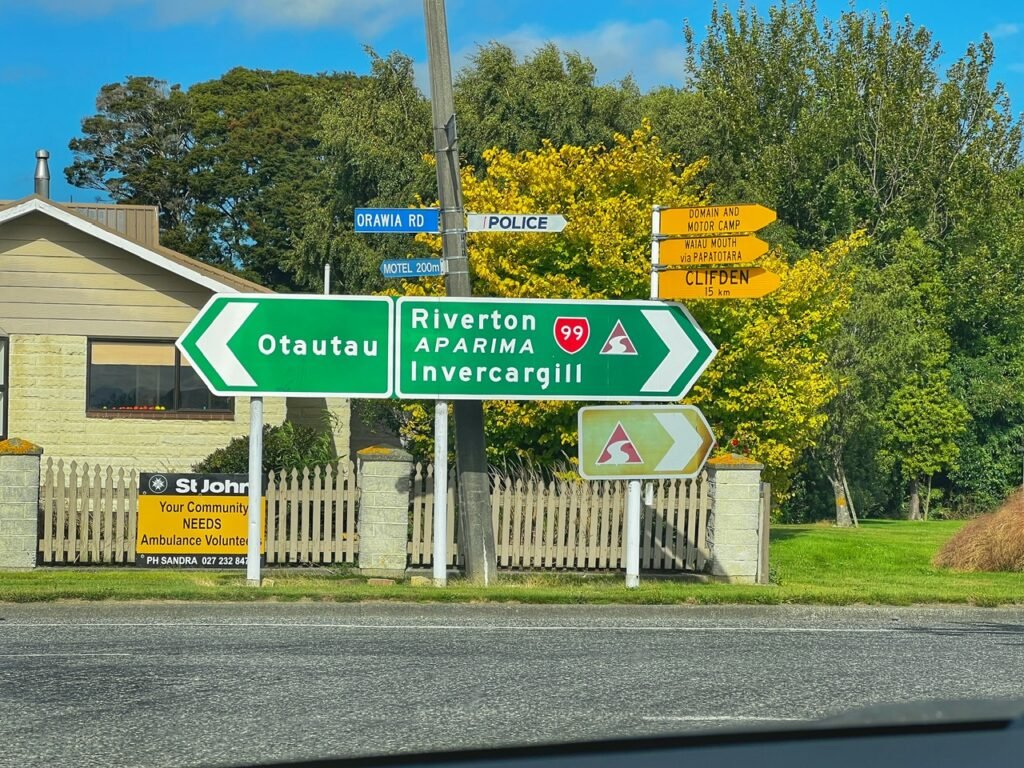
NZ road signs
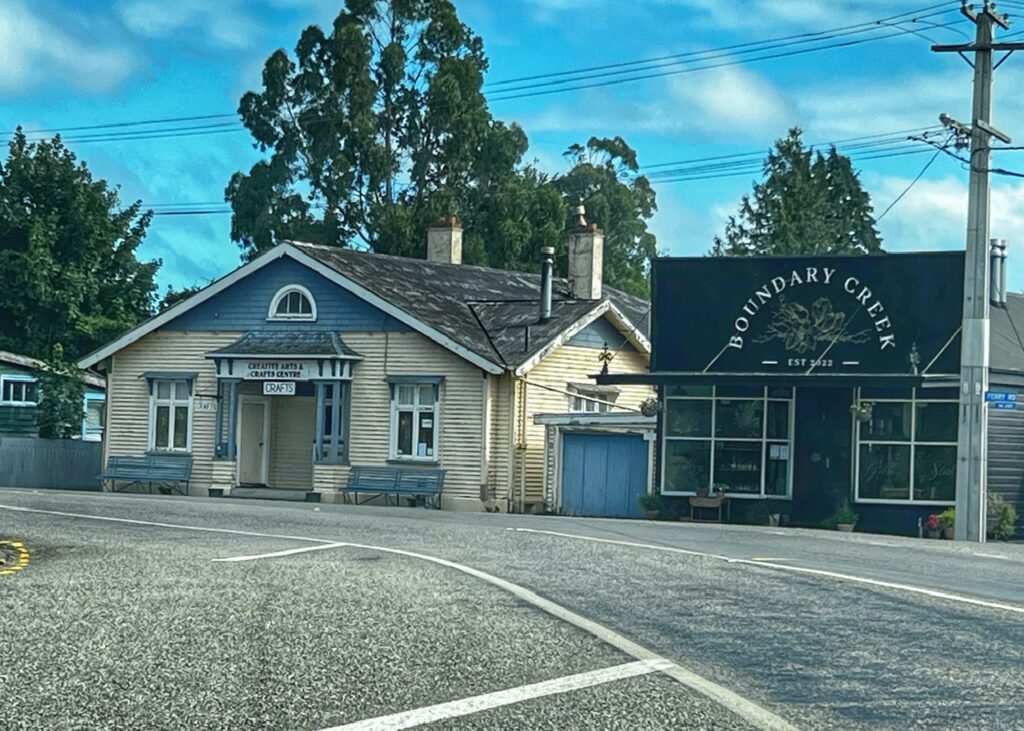

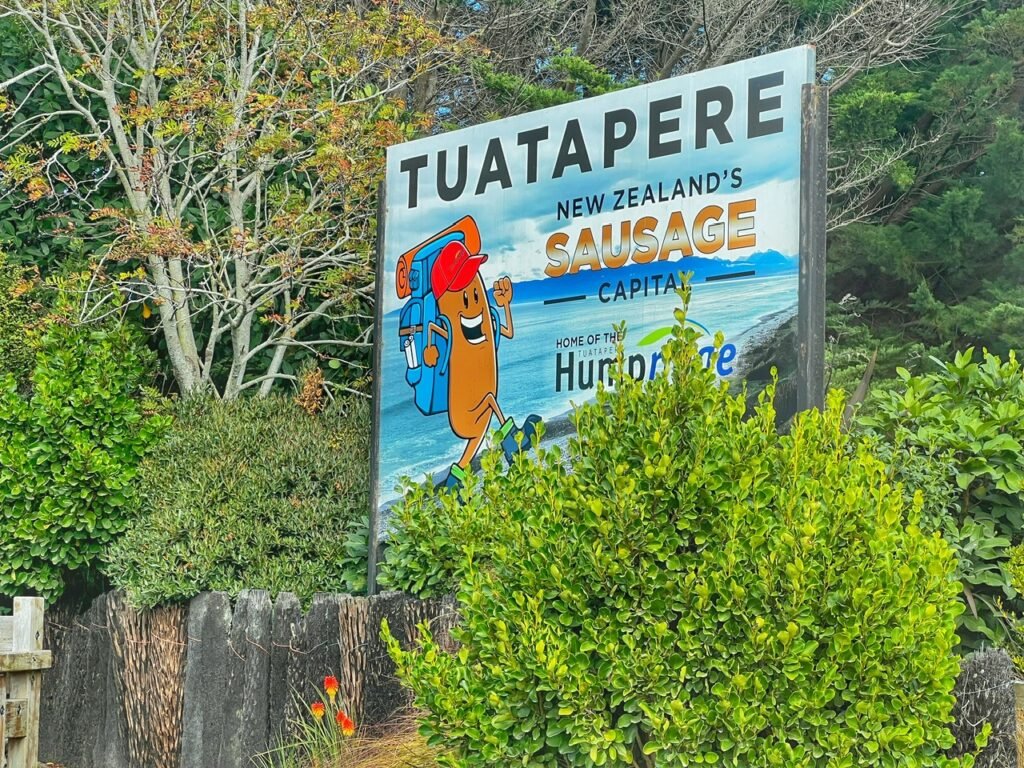
One of many tiny towns along our 3.5 hour drive. This one is coined Tuatapere, which has a “Great War” aka WW1 library, and also appeared to be the home of a backpacking sausage wearing a now controversially-colored hat.
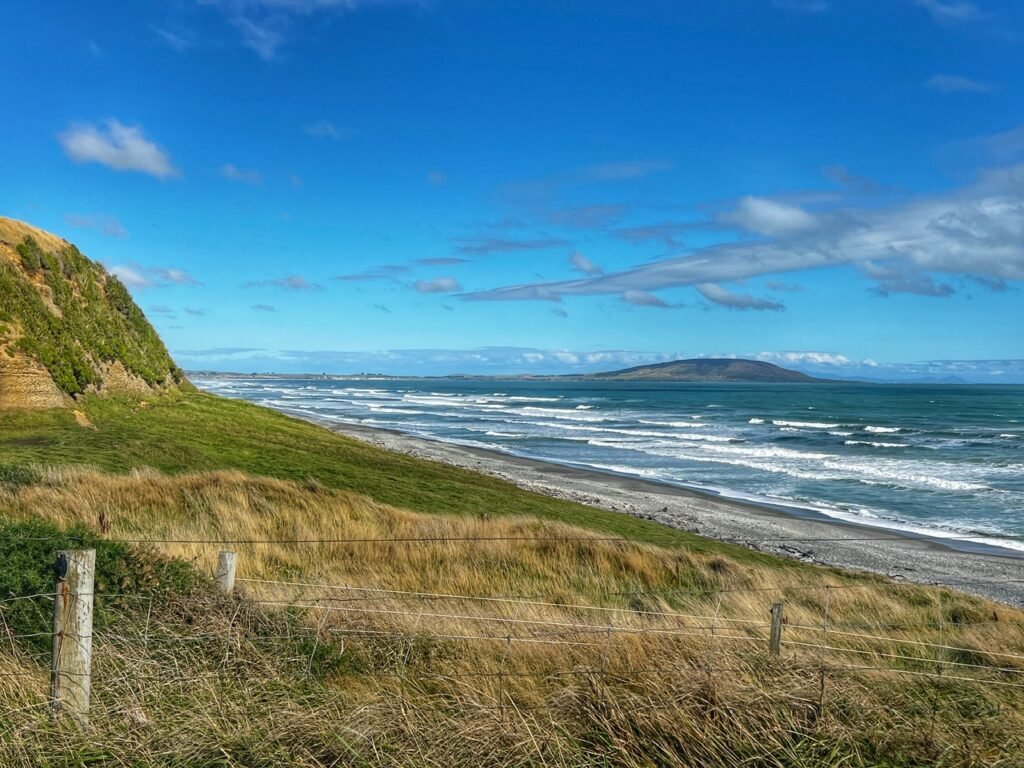
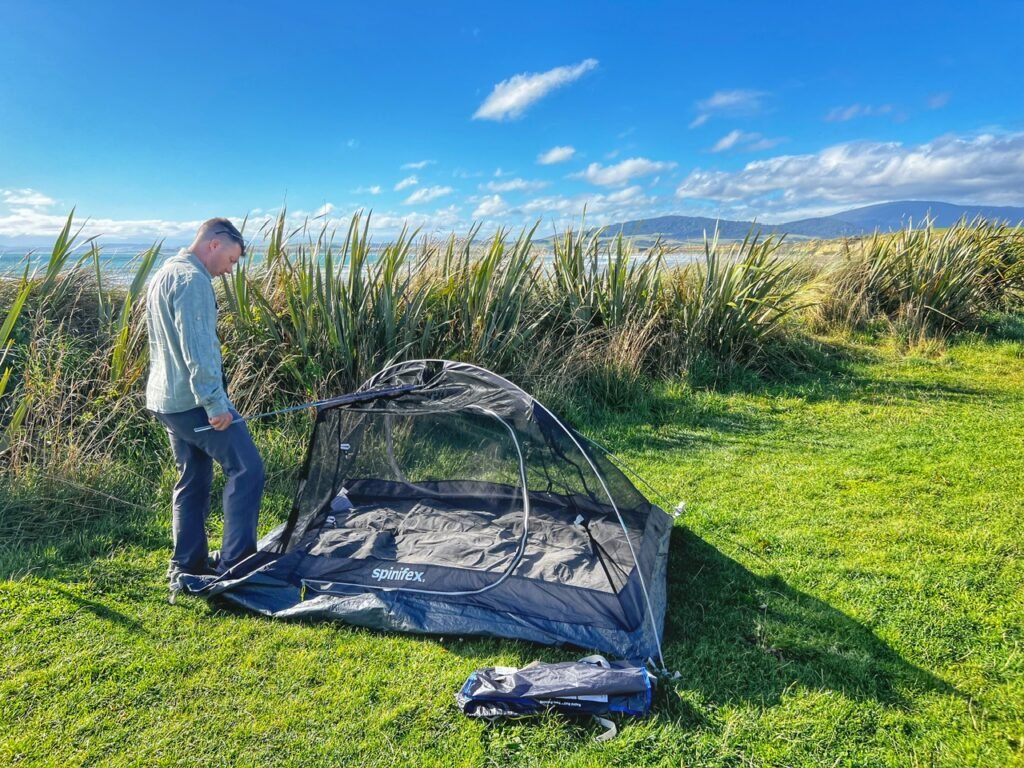
Reaching the southern coast, complete with swoon worthy beaches, including Monkey Island where we decided to plop our tent for free for the night.
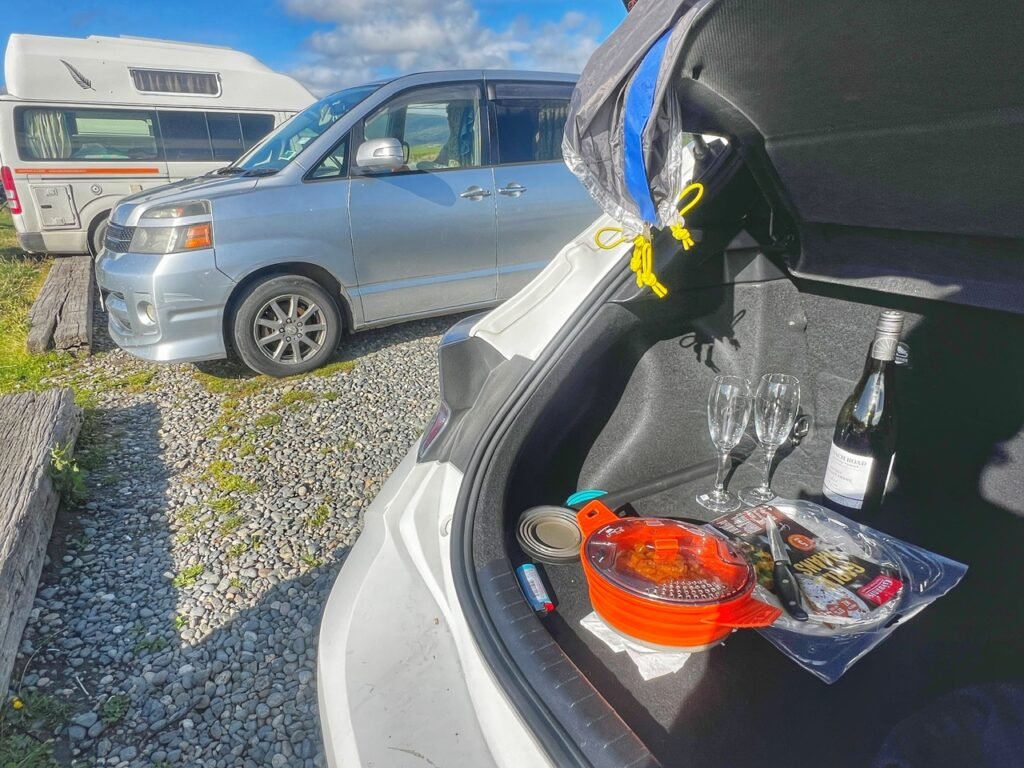
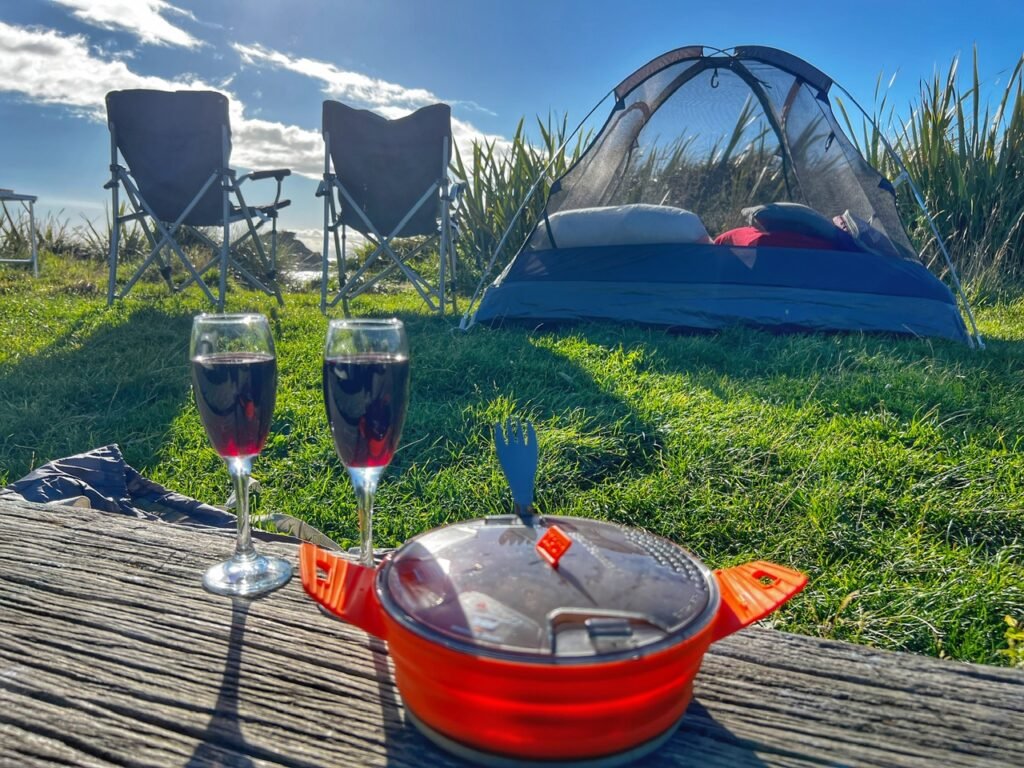
Unfortunately, we were far from the only ones in the parking lot style campsite, again with no picnic tables. That said, we turned our trunk into a kitchen, which included two servings of wine in semi-proper vessels, which we picked up for $.57 each at the opp shop. We also scored two chairs for the evening from our kind Swiss neighbors, which certainly enhanced our seaside dining experience. (As much we would have enjoyed sitting on this parking stump.)

It also marked the furthest south we’ve been in the eastern hemisphere. From near here, many have hopped onto a boat and arrived to Antarctica about 48 hours later.
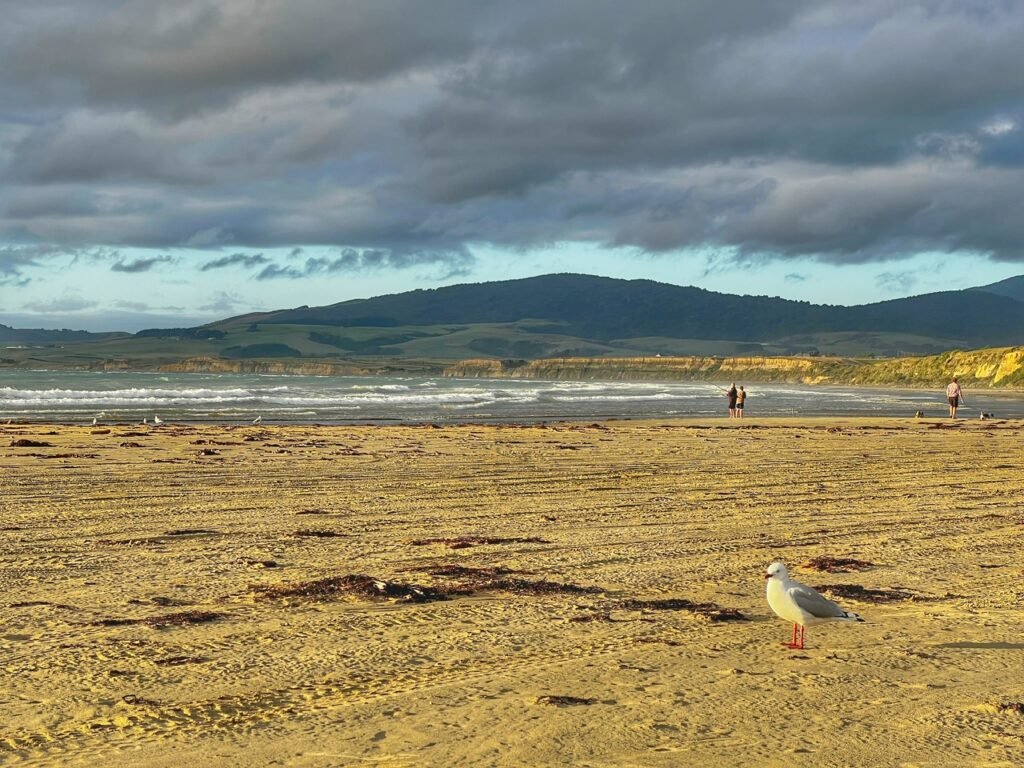
After we slurped down our wine and ate our camp goodies, an evening walk on the beach was due, which offered a nostalgic resemblance to beaches we used to frequent in the Pacific Northwest.
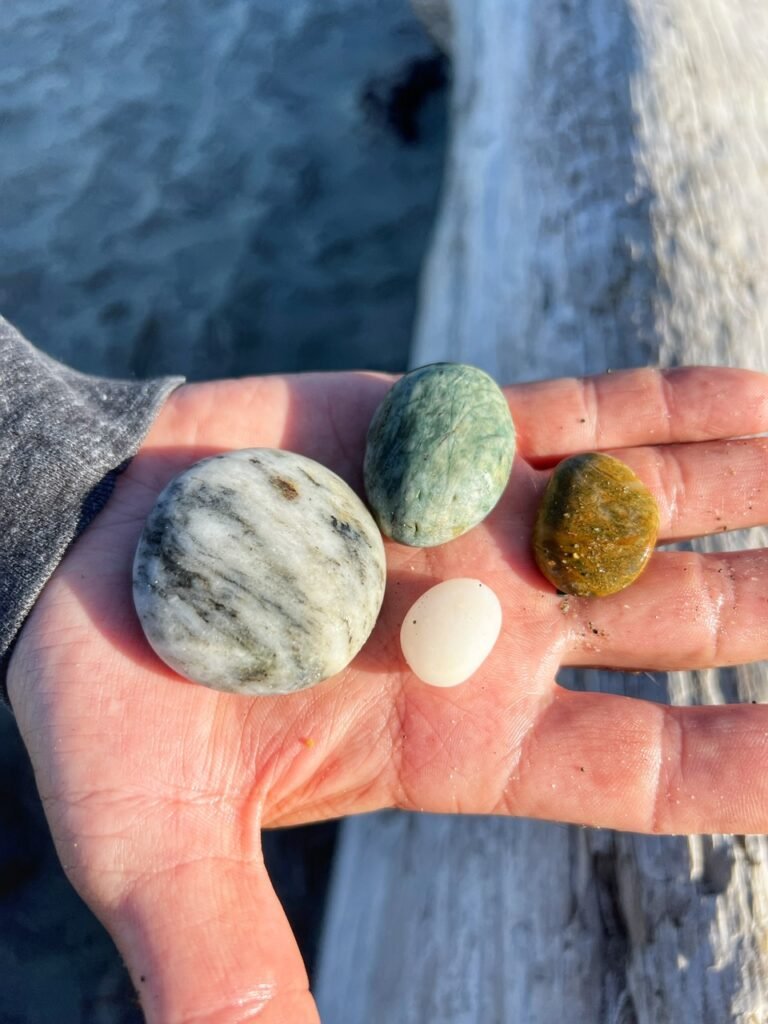
However, the rock findings were definitely more interesting.
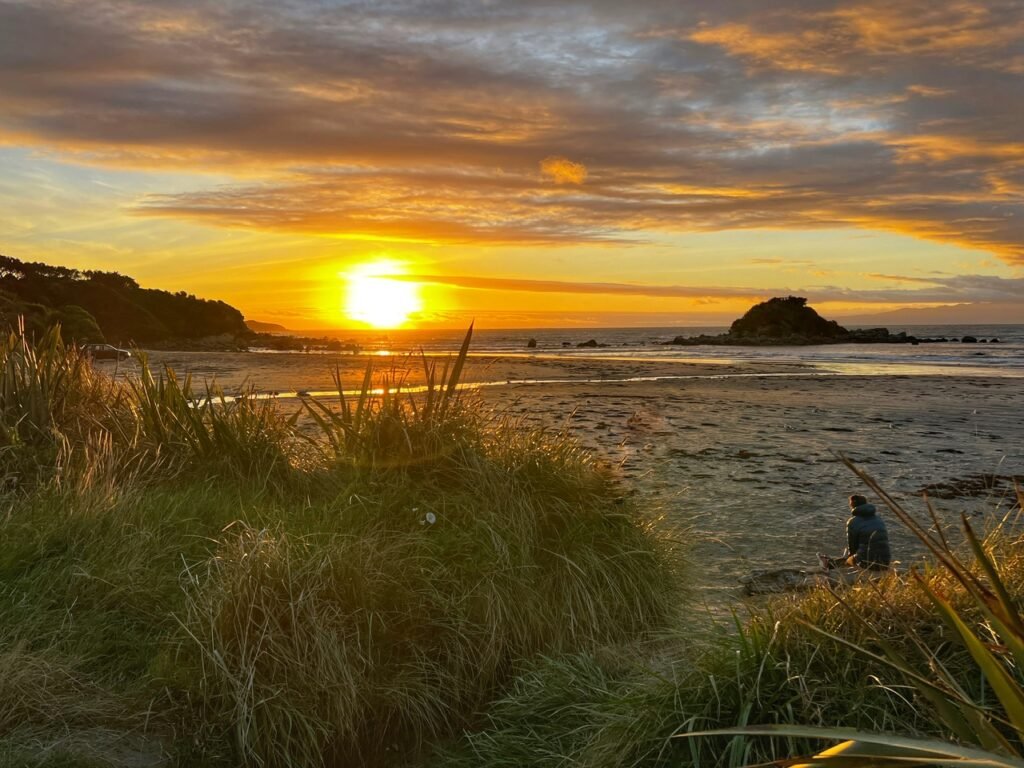
Plus, we still had to make it two more hours until the sun set at 8:40…which seemed to be a regular nightly challenge while camping in the country. Our body clocks are much more into the tropical zones where the sun rises and sets around 6 and you also don’t have to don your puffy coat to enjoy it. 🤣
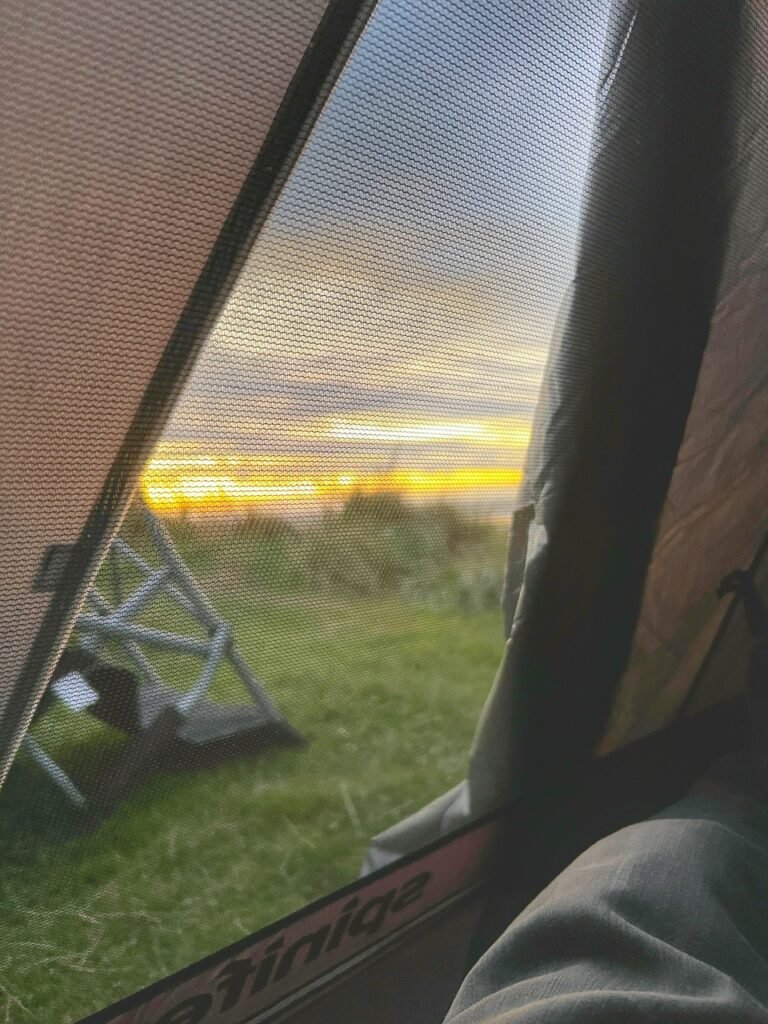
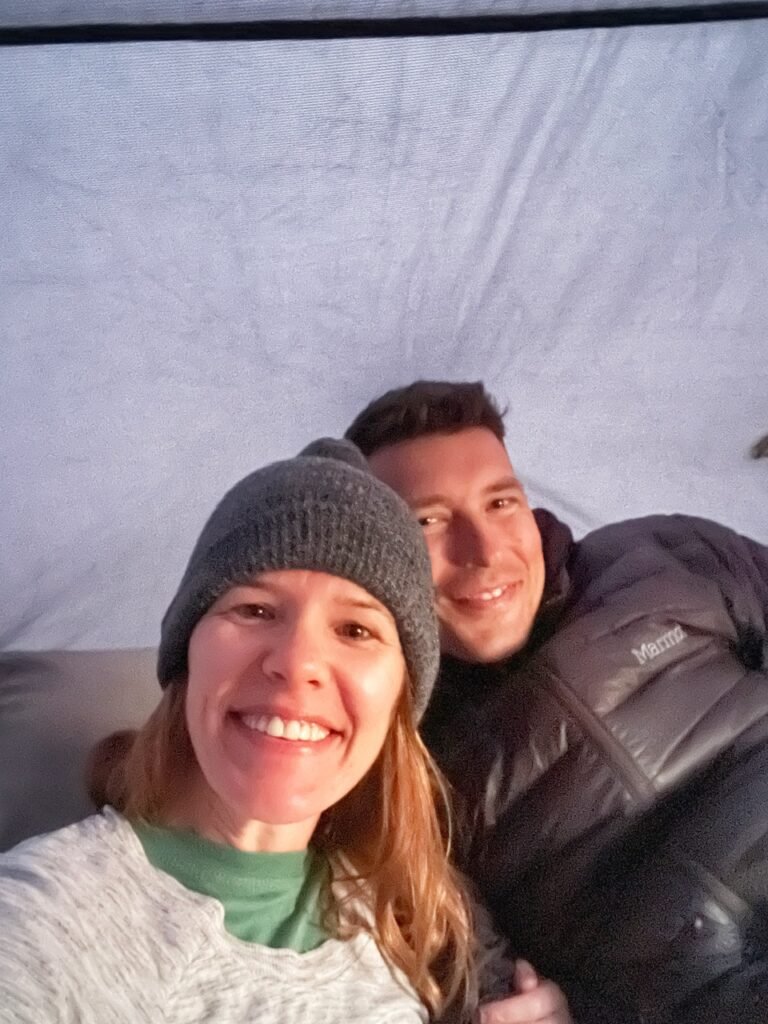
At 9:00, we finally permitted ourselves to head into our tent to read, and begin the warm up process on our noise making mattress. Although the temperatures weren’t quite as frigid as the night at Milford, it still hovered around about 10 degrees over freezing.
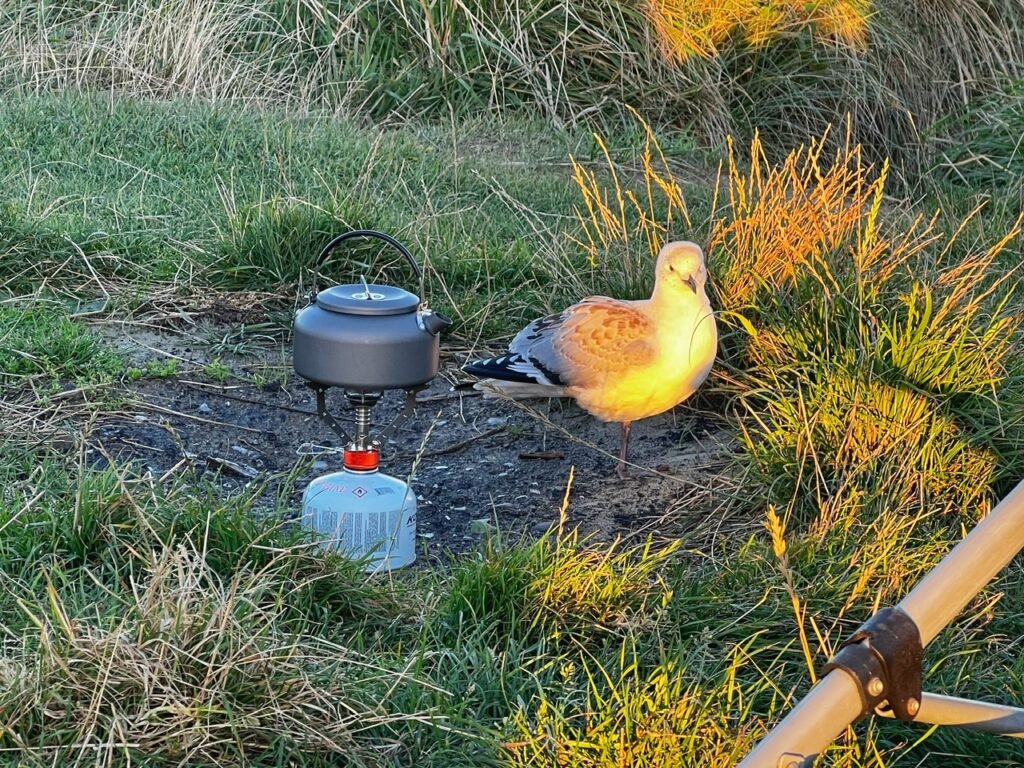
The next morning, we realized we weren’t the only cold ones when we met this seagull contemplating cuddling up with our propane stove. Unlike him, we are just grateful this is not our permanent chilly home near the bottom of the earth.
Day Three: Back in Queenstown (Again)
After our night at Monkey Island Beach, featuring no monkeys, nor islands, we had to head back to Queenstown for the fourth time where we decided to park for two nights in some guy’s caravan parked in his driveway which he had Airbnb’ed for a whopping $70 a night near the airport. This fact was important because we were due to pick up our next rental in two days time….at the airport.
Oh yeah. Yes, we just said $70. $55 exceeding our normal accommodation budget. In Queenstown, we were suddenly at that expense level. Yikes. It was either that…or head to a hostel in central Queenstown and spend $60 while showing up like total hobos with our crate of camping food and garbage bags full of blankets to keep us warm. 🤣
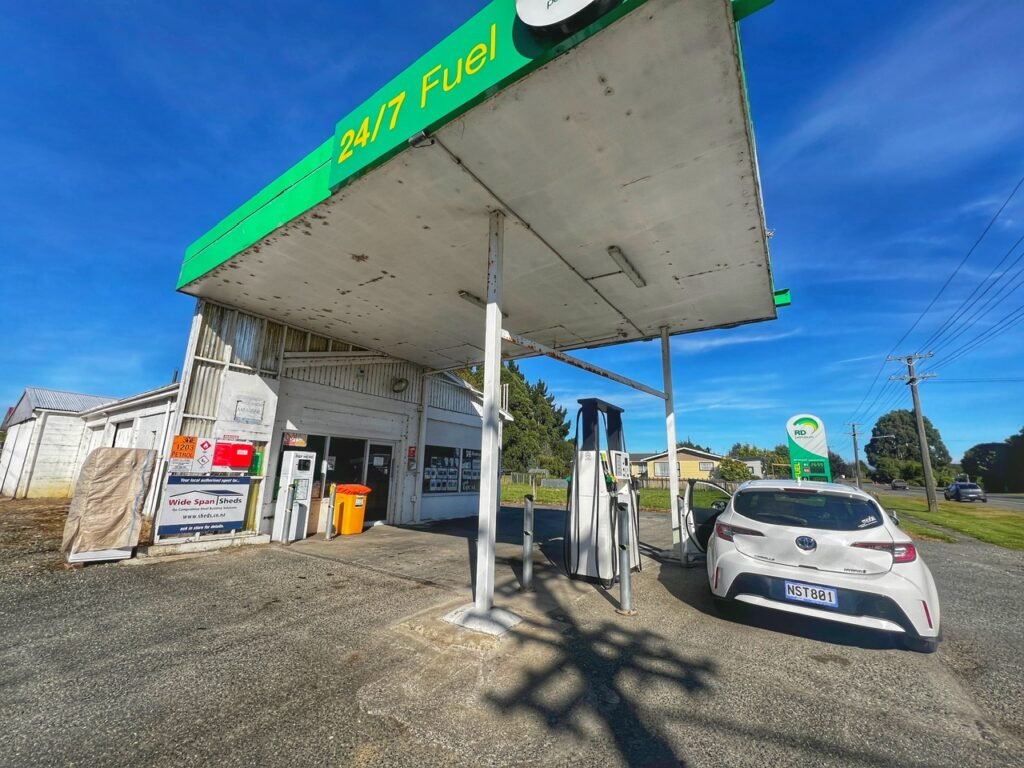
The first photo is of a gas station, where we stopped to fill up our $100/day rental car before we returned it. Why this is interesting is because there are no attendants anywhere at many NZ petrol stations….not even inside the little stores if you want some human interaction.
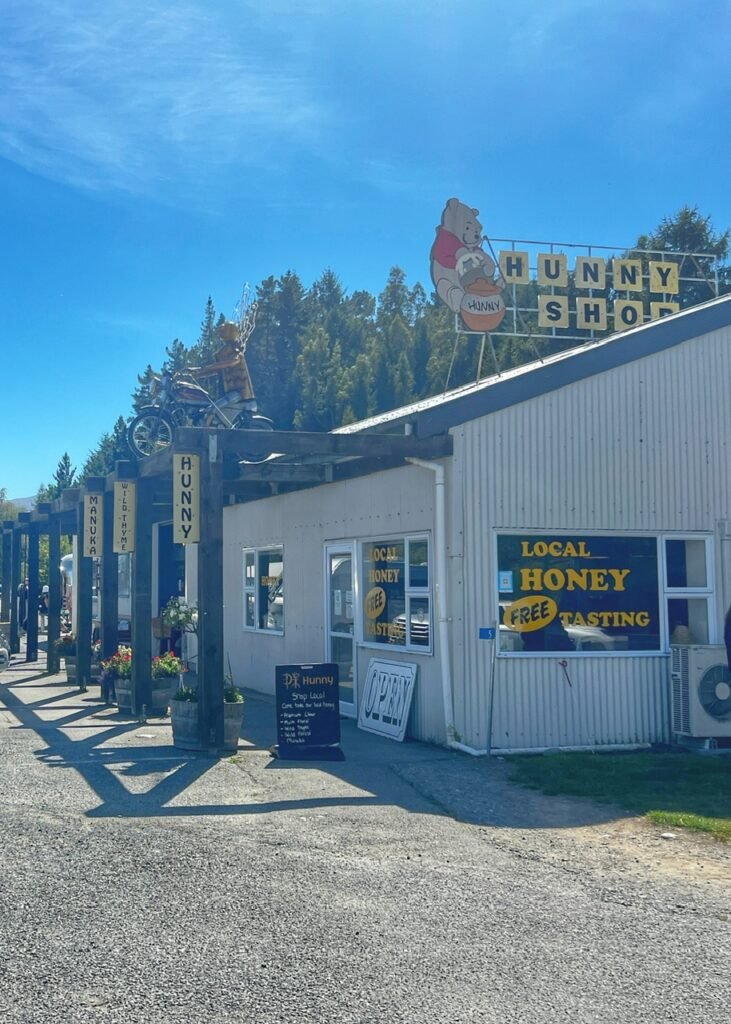
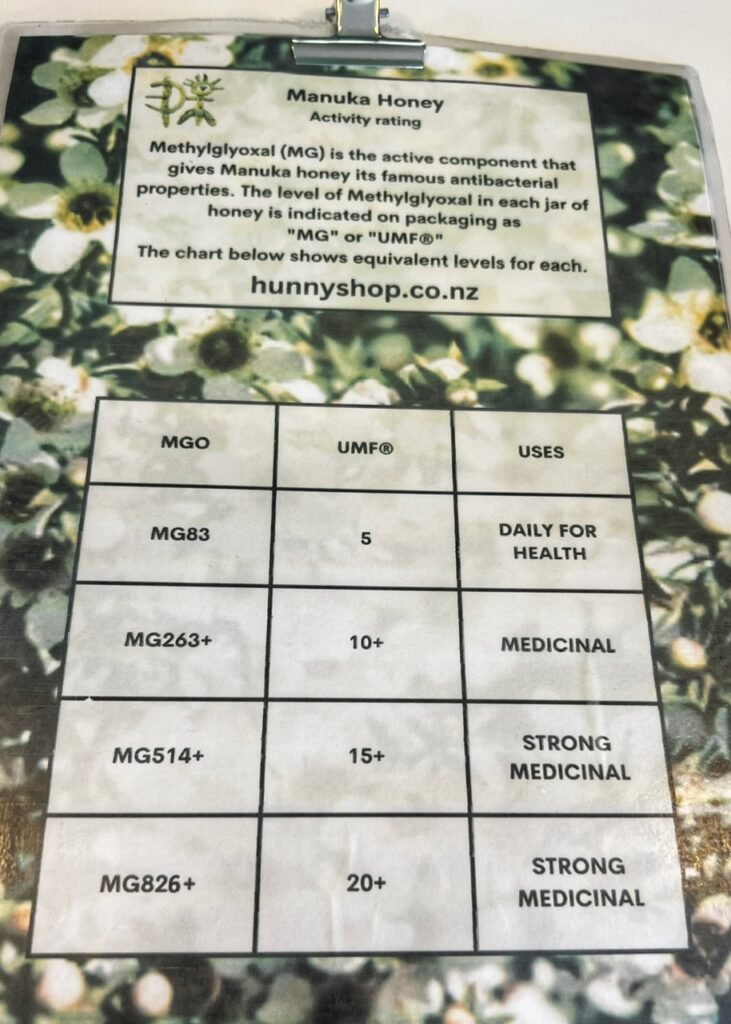
The only stop heading north back to Queenstown was at a very Pooh Bear official looking HUNNY shop, which offered free honey tastings, much to Greg’s delight. Here we got to taste many strains of certified Manuka Honey. In case you’re not aware, Manuka is known for its antibacterial, anti-inflammatory, and wound-healing properties, making it a popular natural remedy and the most healing honey on earth. We learned there are several strains of it from the simple “common cold” healer to the strong medicinal compounds known for healing serious gut bugs.
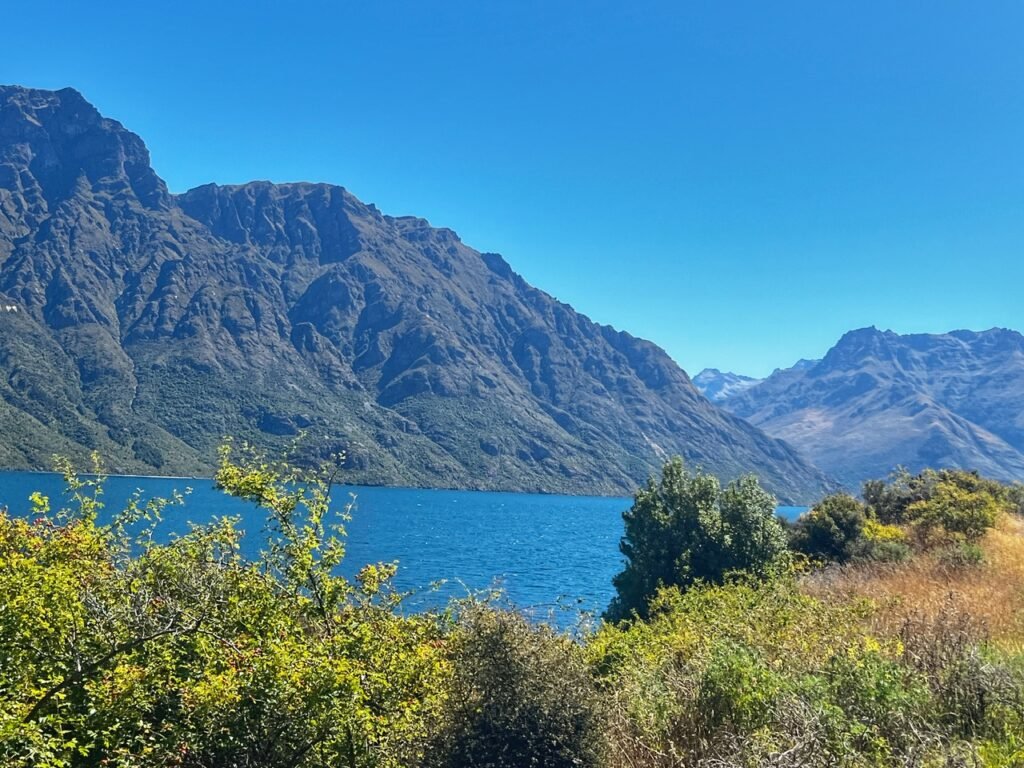
Lake Wakatipu, the massive lake that shares its shores with Queenstown.
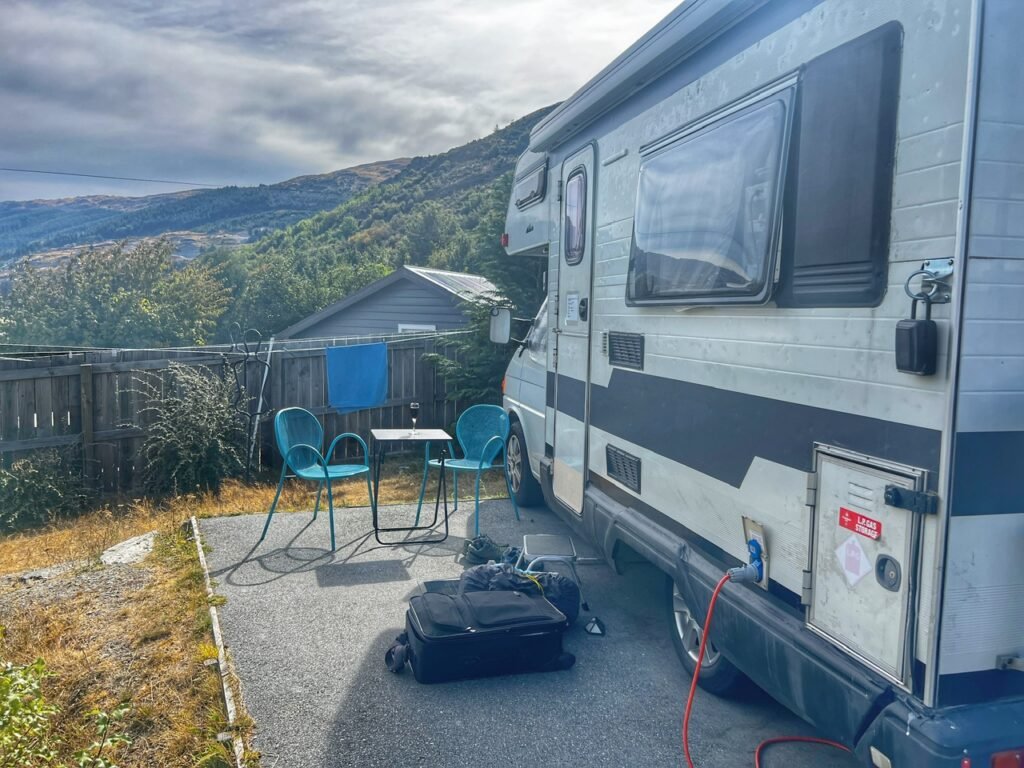
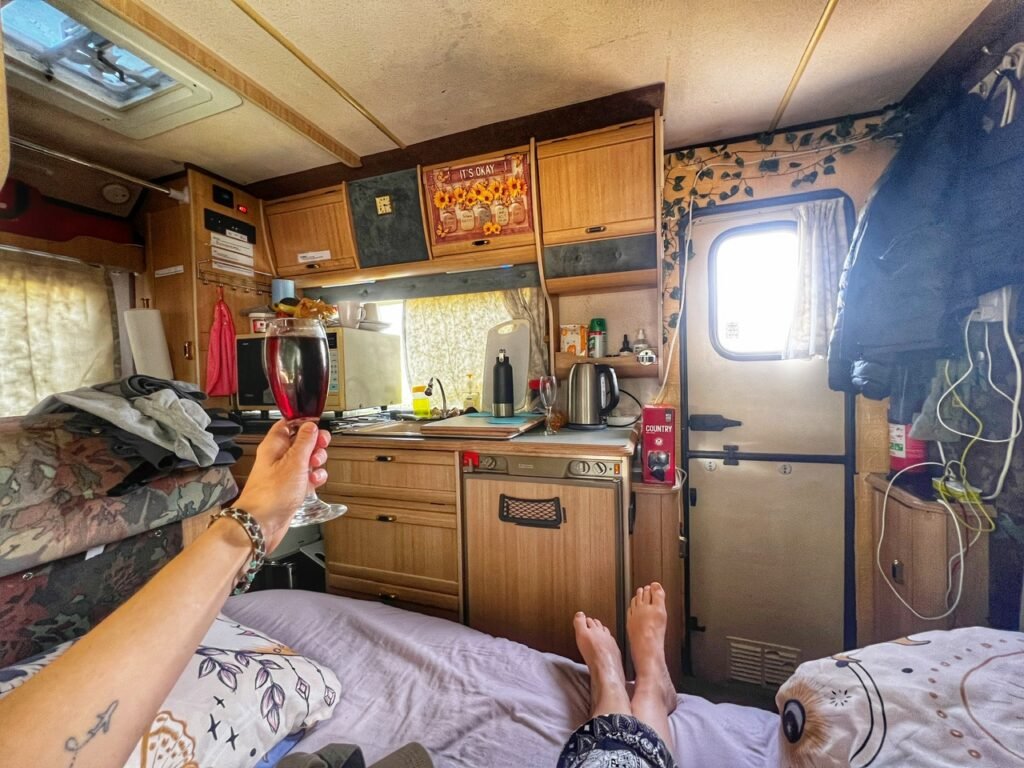
Our parked Airbnb “motorhome experience” near the airport showcasing our own personal fifth wheel out front and piles of crap we had accumulated while in NZ. It felt good to settle in and enjoy our wine.
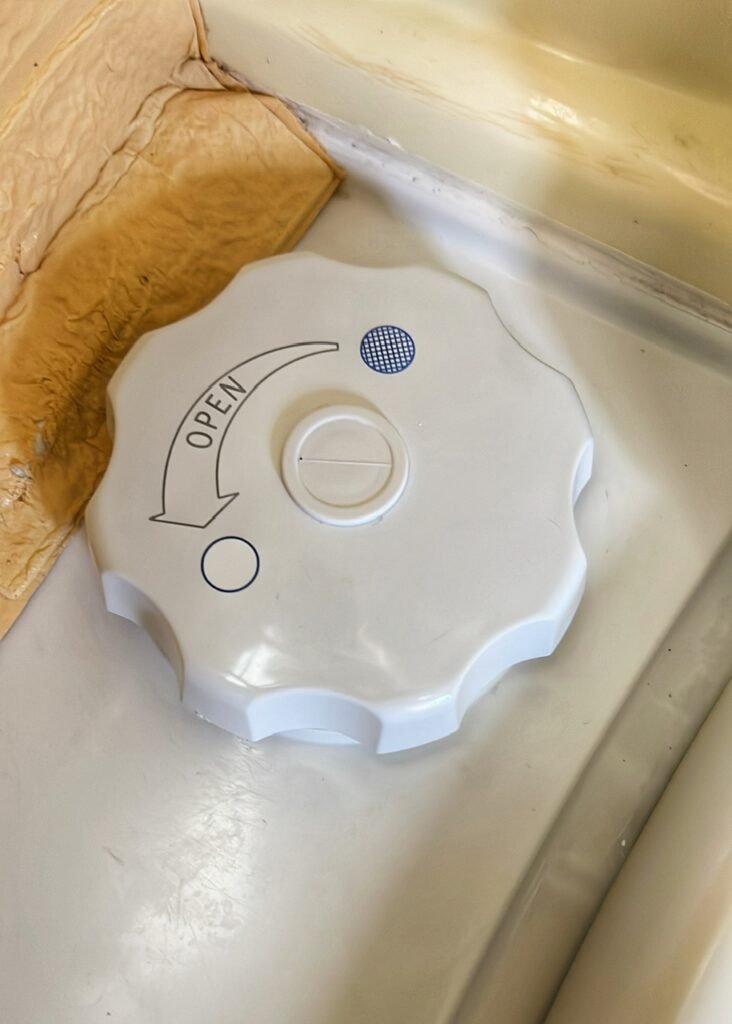
And a bathroom! Complete with a shower curtain which pulled and peeled like a fruit roll up around the interior of the shoeboxed shower and a poop shoot which we had to open and close the smell vault on . Oh yes…it was the real motorhome experience.

